Monday, 29 April 2019
Wednesday, 17 April 2019
Habitat variety crucial for Jays as temperatures warm
Researchers at the University of Southampton have shown that an even range of habitats – chiefly forests, fields and meadows – are needed in an area of around 200 m2 to 1 km2 in order for Jays to thrive.
The data, published recently in Methods in Ecology and Evolution, showed that the higher the temperature, the more important it it is for Jays to have a mix of different surroundings in a relatively small space, with an even spread of coniferous and broad-leaved forests also necessary.
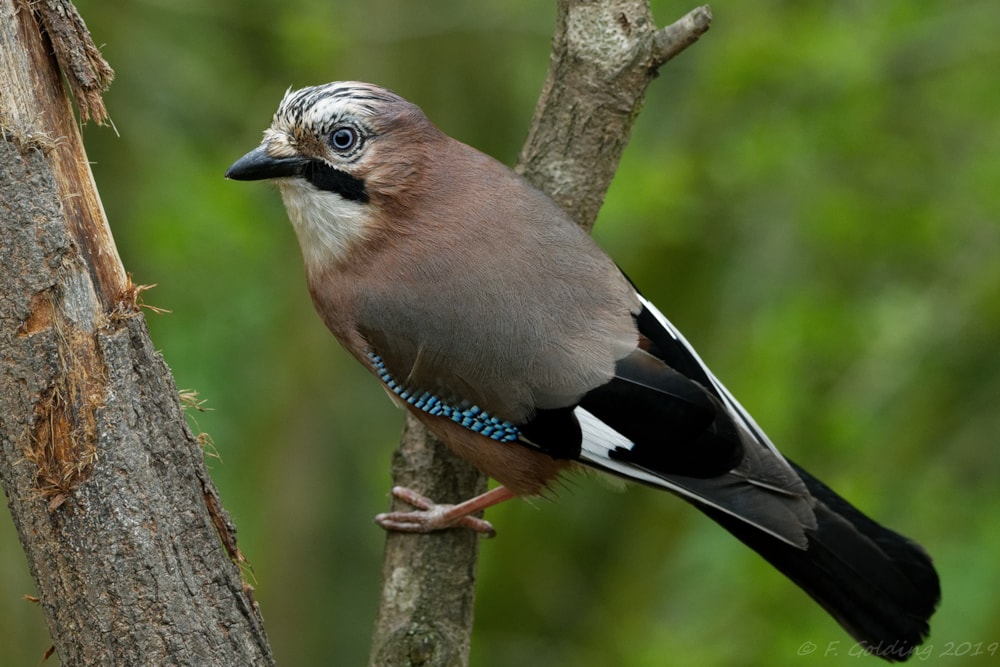
Data from the latest BTO Bird Atlas was studied, along with satellite imagery of Jay habitat (Frank Golding).
The study shows how habitat management will become increasingly important as temperatures rise. Data from the BTO's Bird Atlas 2007-11 was studied by the researchers, who focused on Jay as it's a species known to frequent a variety of ecosystems. The Atlas was one of the most ambitious volunteer projects undertaken, with volunteer surveyors allocated squares of land around Britain in which they counted every bird during winter and in the breeding season.
The University of Southampton researchers gathered this data and combined it with satellite imagery of Britain to obtain a complete picture of the habitats in which there was an abundance of Jay, and how a changing climate affected their numbers. The success of the trial means that this method of studying wildlife numbers could be an effective way to look at the impact climate change has on habitats for other species.
Dr Laura Graham, Postdoctoral Research Associate at the University of Southampton, said: "One of the key challenges in ecological climate change research is gaining an understanding of how climate interacts with changes in habitat to impact species' abundance and distributions. The method we developed for this project allows us to do this."
New effort to save Critically Endangered 'Kiwikiu'
Hawaii state government is stepping up efforts to help the Critically Endangered Maui Parrotbill – of which fewer then 300 are thought to remain in the wild – in a bid to increase the species’ population.
Maui Parrotbill lives at high elevation in the rainforests of Maui and the birds were previously found throughout the forest in leeward Haleakala. However, this area has been badly damaged by hooved animals over the past few decades and state crews will now work to restore much of this forest.
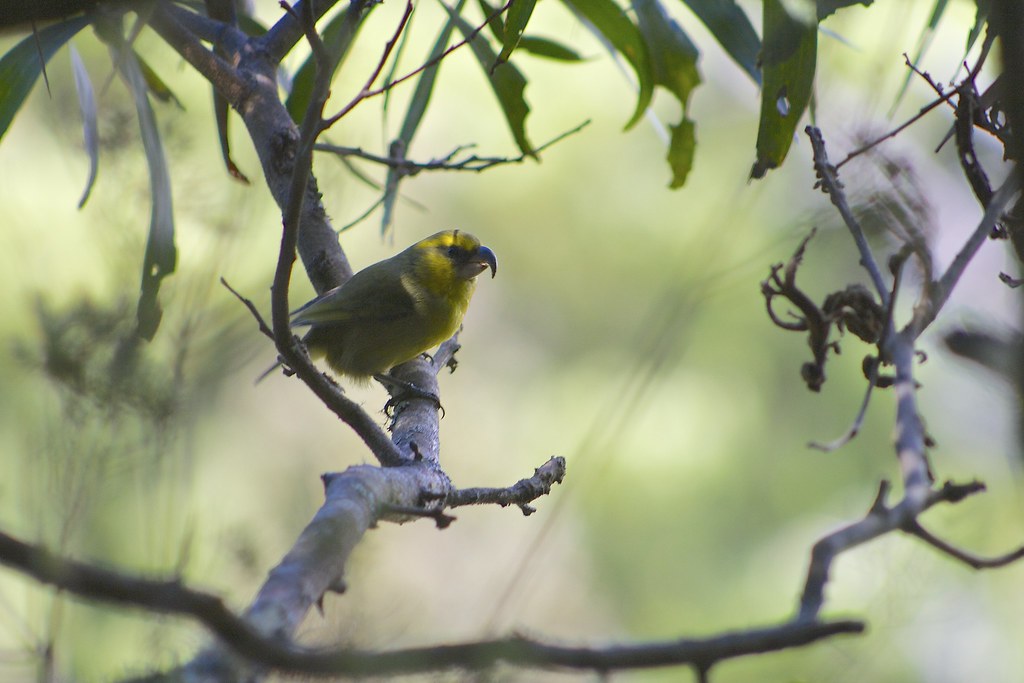
Less than 300 Maui Parrotbill remain in the wild (Andrew Smith/Flickr).
Part of the restoration work includes installation of fencing and planting of native plants and trees. Once this part of the project has been complete, a team plans to release up to 20 Maui Parrotbills in the area later this year. Hannah Mounce, of the Maui Forest Bird Recovery Project, said: "We chose this spot for a future release site for the Critically Endangered birds from the windward side and step one was to bring the forest back."
Maui Parrotbill is one of the larger Hawaiian honeycreepers, favouring undisturbed wet forests dominated by Metrosideros polymorpha and small patches of Acacia koa, with a dense understory of small trees, shrubs, epiphytes, ferns and sedges. Its range is limited, centred between Pu'u 'Alaea, Kuhiwa Valley, Lake Waianapanapa, and upper Kīpahulu Valley – an area less than 2,020 ha – and at elevations of 1,310-2,070 m.
Much of the land in the parrotbill's historic range was changed for agricultural purposes, timber production and animal grazing. Introduced pests, such as mosquitoes, rats, and feral ungulates directly and indirectly affect the parrotbill's survival. Mosquitoes spread avian malaria, which the parrotbill is susceptible to, rats prey upon the birds' eggs and young and feral pigs uproot the low-lying vegetation that the parrotbill forages in. Pigs additionally create wallows, which serve as breeding grounds for avian malaria-infected mosquitoes.
Campaigners call for end of illegal trap use
Leicestershire Rook Rescue has asked members of the public to be on the lookout for illegally fitted Larsen traps. The traps use live corvid decoys – often Carrion Crows or Eurasian Magpies – to lure and then kill others of their kind. They are legal, as long as they are fitted with clean food and water, a perch and shelter from the wind and rain – unfortunately, however, this is rarely the case, rendering many illegal.
The mesh snares, known as the 'Box of Death', have one compartment with bait, and another with twigs lying across an open cage. When a bird perches on them they fall into the side cage and become stuck there. A spokesperson for the rook rescue group said: "As wildlife rescuers we need to ensure that the public is made aware of these traps and how they are being misused. They cause a great deal of stress and suffering to the decoy bird and death to those which are captured."
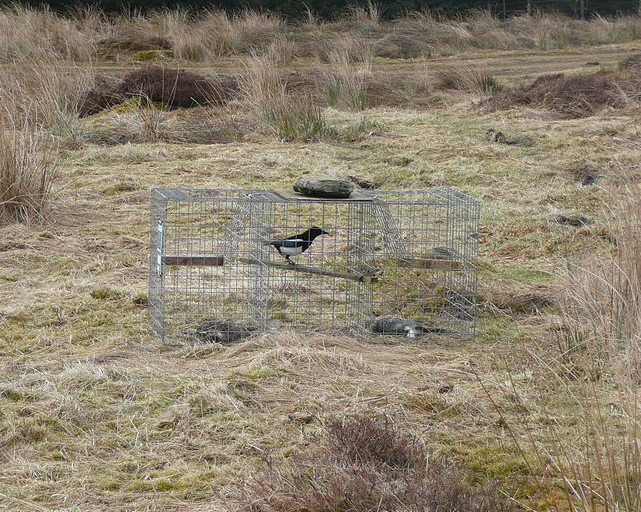
Birds can be left in the traps for days with poor quality food and no water (commons.wikimedia.org).
The Organisation Against Corvid Traps (ACT) said that there are often no provisions (food or water) left for the 'bait birds', which is an offence under the Animal Welfare Act and the Wildlife and Countryside Act, and explained that the countryside is littered with "disgusting medieval traps that leave birds to die of hunger". The group added: "All too often these birds have been left to die of hunger and thirst and in blazing hot sun.
"It is cruel and evil to deny a bird its instinct to mate, nest and hatch eggs at the time of the year when others are doing so. Think of the lonely days and nights it lingers there captive on the ground frightened by marauding creatures of the night."
Trappers will sometimes leave only a handful of dried dog food for the captive bird or fix a rodent water bottle to the side of the trap, which is not fit for a bird’s beak. Leicestershire Rook Rescue has worked with the campaign group and signed petitions to have Larsen Traps banned in the UK. A big difficulty, however, is that gamekeepers leave these traps away from public rights of way, rendering them very hard to locate without trespassing.
Trouble in paradise
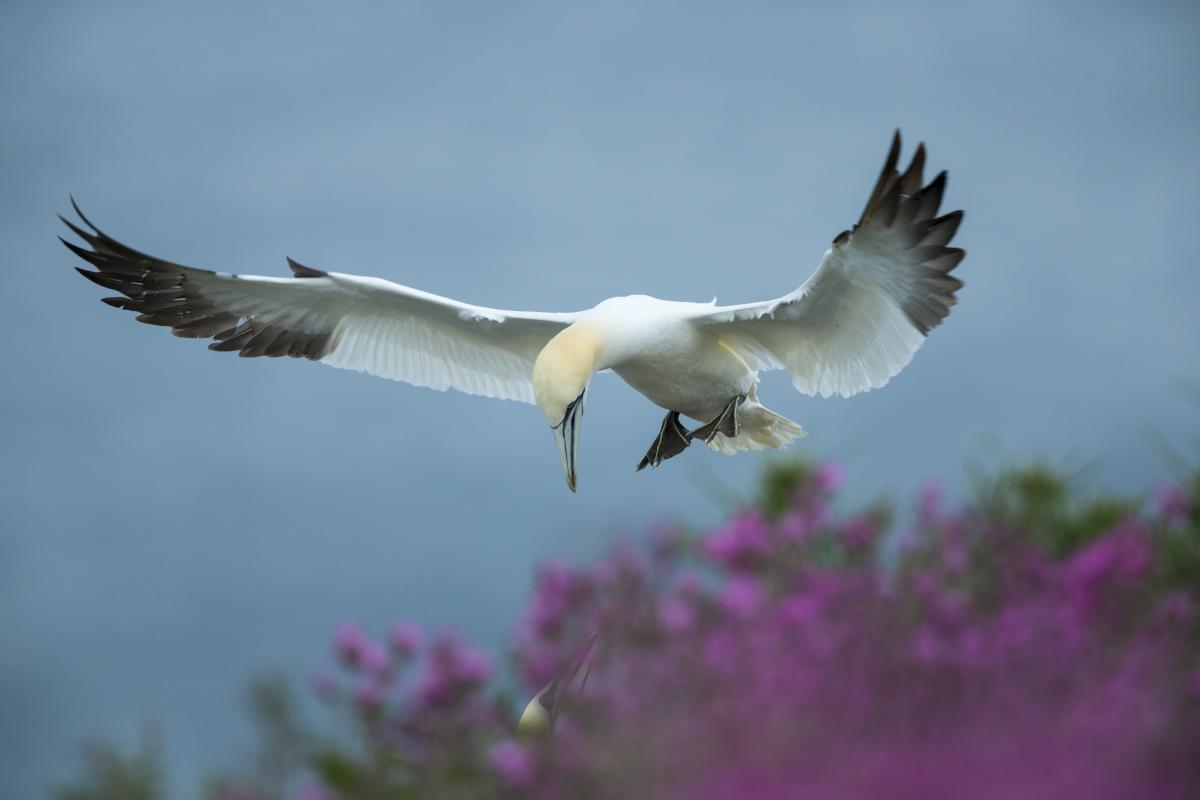
More than two-thirds of the world population of Northern Gannet breeds around the coasts of Britain and Ireland. Plastic is being found in an increasing number of nests (Oliver Smart).
Each year, with collaborators from Australia, I make my annual trip to an island which some describe as paradise, with white sandy beaches, unbleached corals, waving palm trees – and a dark underground secret. In the middle of the Tasman Sea between Australia and New Zealand, Lord Howe Island is home to about 350 people and has a thriving tourist economy, with daily flights from the Australian mainland. It’s also home to thousands of seabirds – shearwaters, petrels, terns, boobies, and more – because until human arrival in the 1780s, the island was free of terrestrial mammals, making it an ideal place for seabirds to raise their chicks.
The island holds the world’s largest breeding colony of Flesh-footed Shearwaters, a large greyish-brown bird with pinkish legs and a black-tipped bill. But a combination of bycatch in fisheries and light attraction on the island meant the population wasn’t faring so well. It was while trying to understand these pressures that a relatively new one reared its ugly head: plastics.
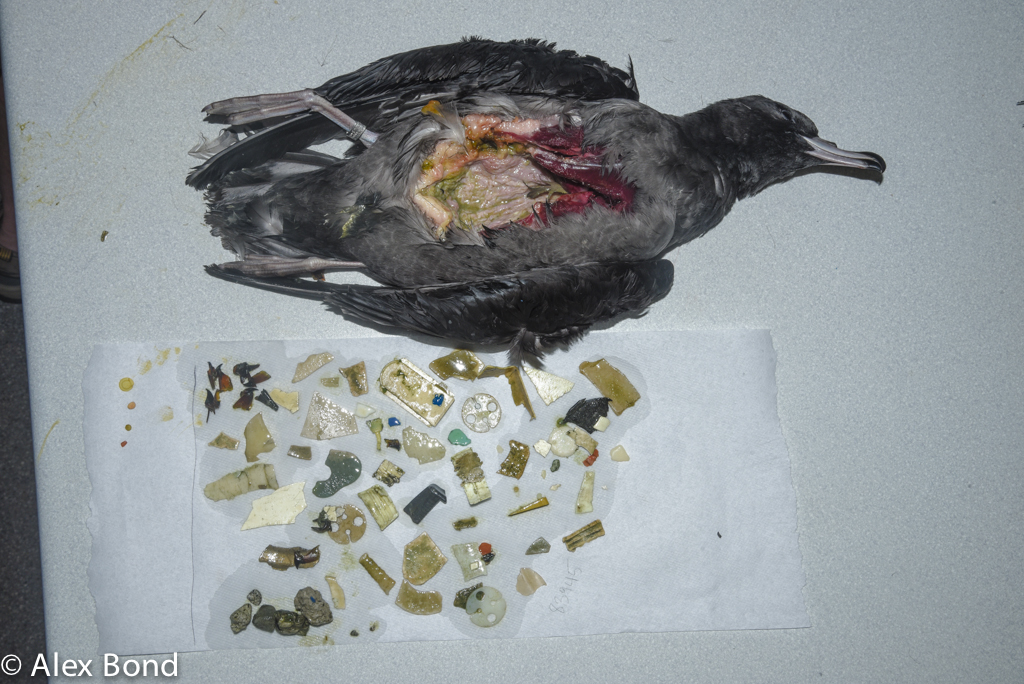
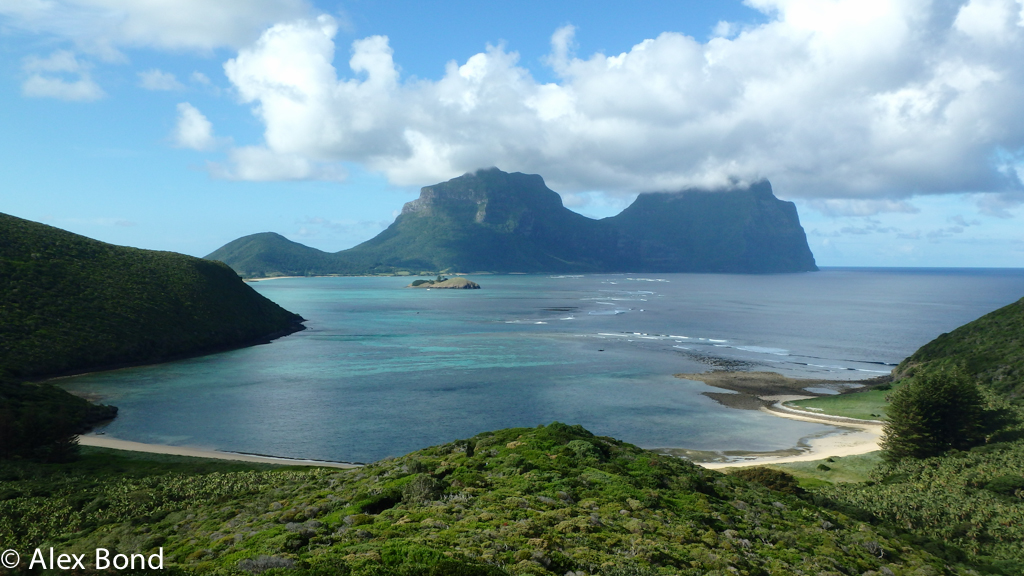
The Flesh-footed Shearwaters (top) of Lord Howe Island (bottom) in the Tasman Sea are ingesting plastic waste from around the world, sometimes up to hundreds of pieces (Alex Bond).
These polymers, composed mainly of hydrocarbons, were first developed in the mid-1800s as an alternate material to ivory for billiard balls. Now they comprise many different types: polyethylene, silicones, polyesters and more, with each corresponding to one of the numbers 1-7 that we see in the recycle symbol (with 7 being a catch-all for anything not numbered 1 to 6).
Production really took off in the 1950s, and now more than 300 million tonnes of new plastics are made every year. But unlike many of the materials they replaced, plastics don’t disappear or break down – they only break up into ever smaller pieces. Of the billions of tonnes of plastic produced in the last 70 years, well over 95 per cent of it still exists somewhere in the world. But what does this mean for birds?
The problem with plastic
Birds can experience two main impacts from plastic pollution: entanglement and ingestion. The former is the less well-documented of the two, but is often the more lethal. Birds can become tangled in abandoned fishing nets (‘ghost nets’) at sea, and species that build nests, such as gannets, boobies, gulls and albatrosses, often mistake it for natural materials like seaweed and actively collect it to incorporate it into their nest structure.
In Britain, this is most visible at Northern Gannet colonies, and in particular at Grassholm in south Wales, where plastic debris, usually ropes or nets, is found in practically every nest and cumulatively weighs almost 20 tonnes. Each year, wardens, researchers and volunteers go out to cut lose any birds they can, averaging more than 60 a year. So far this hasn’t affected the population, but the fact remains that at gannetries across the Atlantic, these birds’ deaths are preventable.
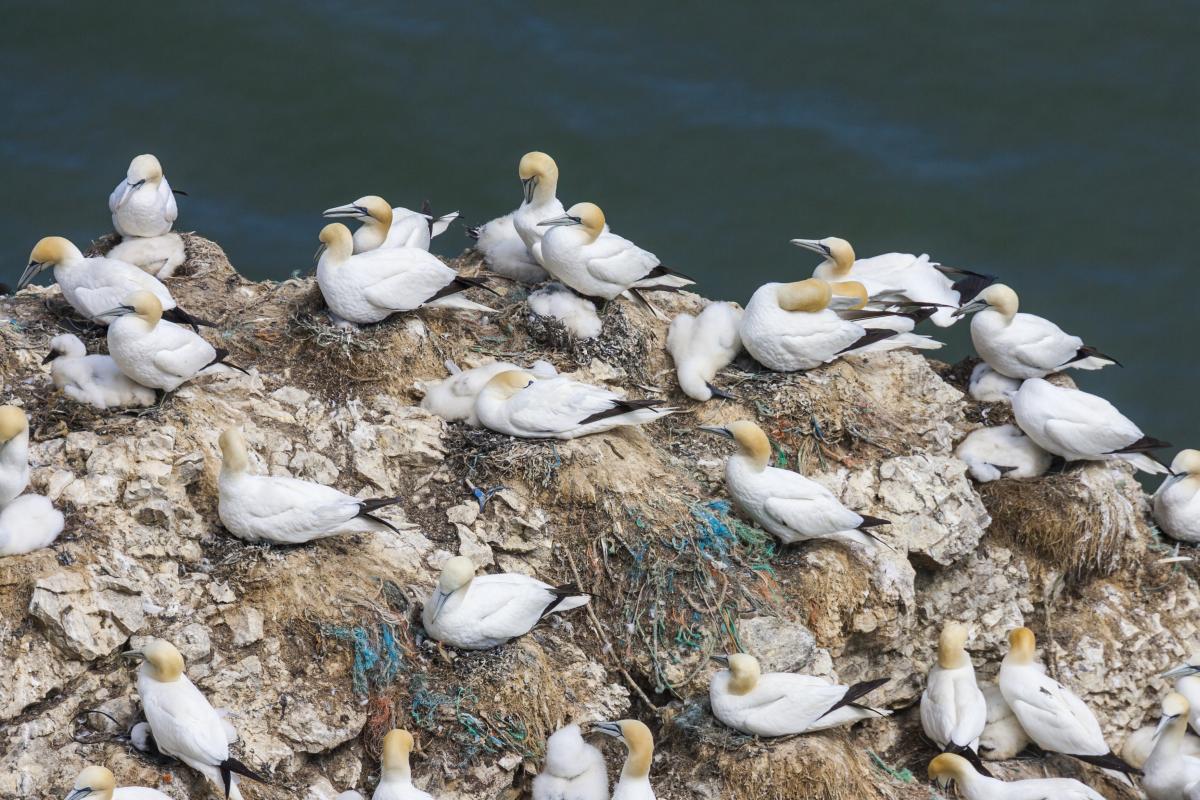
The gannetry at Bempton Cliffs, East Yorkshire, is blighted with plastic pollution as the birds incorporate it into their nests (Oliver Smart).
On Lord Howe Island, the threat isn’t from shearwaters becoming entangled in fishing debris, but rather from ingesting pieces of plastic. For 80-90 days, the chicks remain in their 3-m-long sandy burrows as their parents bring food back from the Tasman Sea. When all goes well, the chicks will weigh nearly 900 grams, almost 20 per cent more than the adults. But increasingly, the chicks’ meals have become a toxic soup. Some years, every chick is fed at least some plastic; we can examine this when the chicks emerge from their burrows at the end of the breeding season by flushing their stomachs gently with water so that they regurgitate the plastic that has accumulated inside them.
Alongside the sort of things you might expect (fish bones, hard parts from squid and the odd feather), we also find bottle tops, ballpoint pen caps, clips from helium balloons, glow sticks from squid fisheries and countless other unidentifiable items. The birds that have more plastic in them have less room for nutritious food, and sadly starve to death with their stomachs full. In one single bird, we counted 276 pieces of plastic weighing 64 g. That’s the equivalent of about 12 kg for a human. These chicks often weigh just 400, 300 or even 200 g and face grim prospects for survival.
We often find birds on the beach, having tried to fledge the night before, but unable to make it past the waves because they are too weak to fly. Some have already been scavenged by ghost crabs, while others cling onto life. The birds in better condition stand a chance – we can flush their stomachs, feed them a squid smoothie and release them the following night. Most are too far gone and don’t survive the day, but even those that do make it are already playing catch-up – they often weigh less and have shorter wings than birds without plastic, which makes their migration to the Sea of Japan that much more challenging.
Even when birds only have a few pieces of plastic, each of those fragments can be an individual toxic bullet. Plastics act like sponges for contaminants in the ocean, sopping up persistent organic pollutants and metals which can be transferred to birds when the plastic is ingested.
Figuring how much contamination comes from the plastics rather than from prey isn’t straightforward, but the case of polybrominated compounds provides a useful example. Polybrominated diphenyl ethers (PBDEs) are a group of compounds usually used as flame retardants and found in a wide array of household and commercial goods, including electronics, furniture, building materials and textiles.
When scientists looked at the different congeners (the different kinds of PBDEs) in Short-tailed Shearwaters, they noticed that some were common between the birds and prey, which makes sense. But a new and troubling discovery was that some congeners in the birds were completely absent from the fish and squid they ate, and could have only come from one source, where it was quite common: plastics.
Closer to home
So what do we know about seabirds and plastic in Britain? Surprisingly little. When we reviewed the state of knowledge around plastics and seabirds across the eastern North Atlantic, we found that we knew less than we thought, and much of our information was outdated or likely not representative.
Of the 79 seabirds and seaducks that occur regularly in Britain, there are no data on plastic ingestion, entanglement or nest incorporation for 48 of them (a whopping 61 per cent). Nine others have single reports from one site in one year, and only nine have information from multiple sites in multiple years. But even this is overly optimistic, as in many cases the sampling is 20 or 30 years old and plastic production has been increasing exponentially since the 1950s – can these data still be reliable in the face of such increasing pressures?
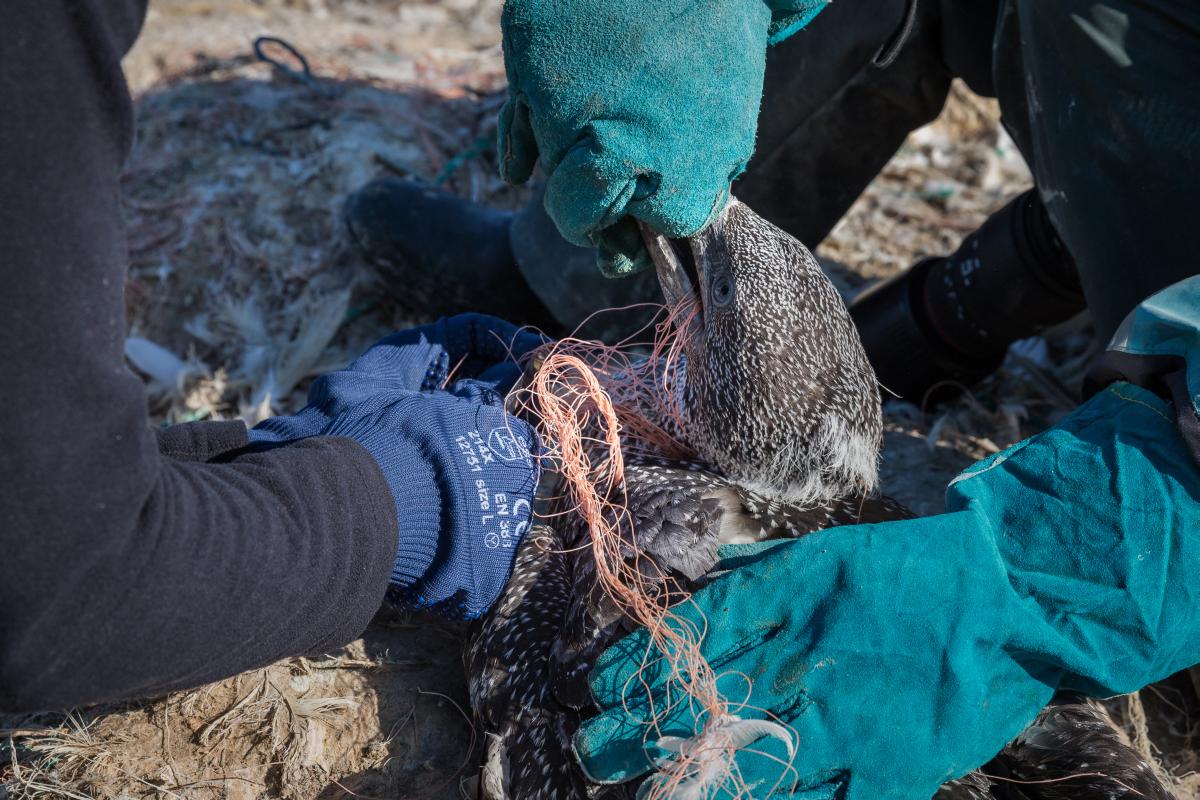
At the Northern Gannet breeding colony on Grassholm Island, Pembrokeshire, volunteers head out every summer to release birds tangled in discarded rope and netting (Drew Buckley).
Some species, such as Manx Shearwater, are iconic British seabirds, and yet the data we have is from 1983-1985, and consists of just over 10 individuals. What’s more, the data reported is often missing some key information, including the sample size or how many individuals contained plastic, and 95 per cent of studies don’t report data on plastic mass, which is arguably more important than presence or absence or the number of pieces – a small bit of film plastic has a different impact than a whole bottle cap, for example.
An international issue
Tackling such a pervasive problem as plastic pollution isn’t easy. The very properties that fuelled the rise in plastic use – its malleability, durability and light weight relative to other materials – are exactly the traits that make it difficult to manage. Because most plastics float, once they get into the ocean they can circle the globe. In 1992, a dozen containers were washed off a cargo ship in the North Pacific. Inside were tens of thousands of rubber ducks and other plastic bath toys. Over the next two decades, they washed up on beaches around the world, reaching Britain in 2003.
For the last 20 years, pieces of Lego have been washing up on the beaches of Cornwall and Devon from a container that went overboard in 1997. On Henderson Island, the most polluted uninhabited remote island in the world and part of the Pitcairn Islands in the South Pacific Ocean, we found identifiable plastic on the beach from as far away as Spain and Scotland.
With 80 per cent of marine plastic debris coming from land-based sources, mainly gaps in waste management systems, addressing it requires a global effort not unlike climate change. International environmental policy moves slowly, but compared to climate change, plastic pollution is at least 30 years behind – there is only acknowledgement that the problem exists. And we all know how much more work there is to do around climate change and the international community. There are no concrete strategies or targets (voluntary or binding), only vague commitments and a problem that shows no signs of slowing down.
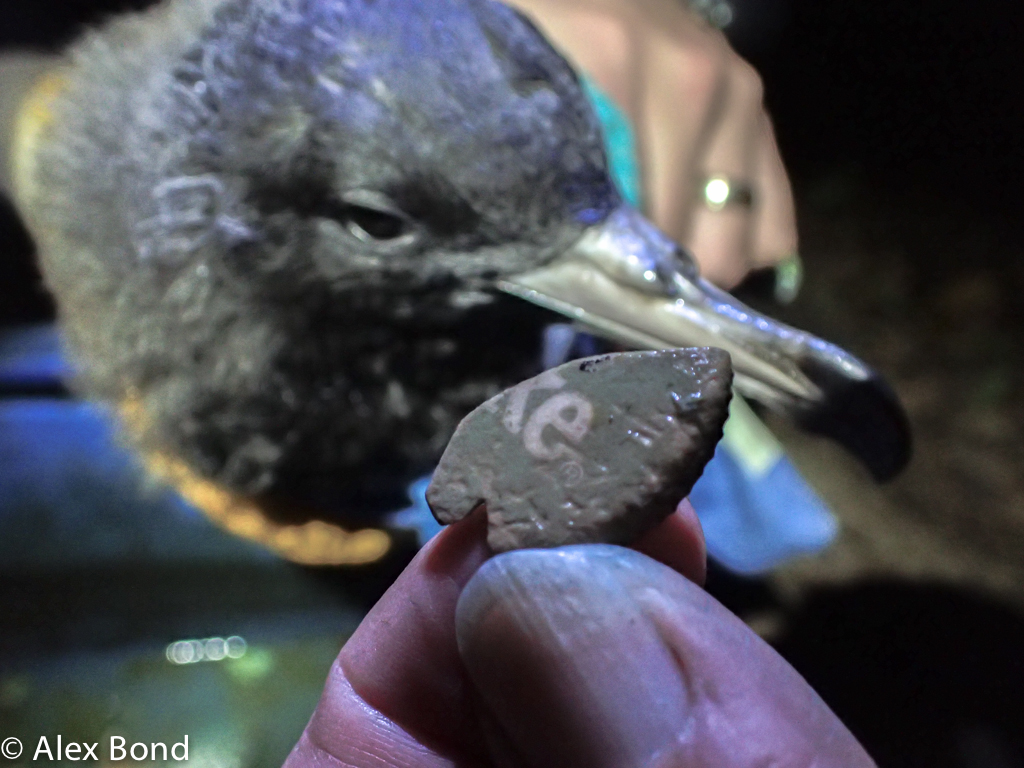
Some Flesh-footed Shearwaters can be saved by flushing their stomachs so they regurgitate the plastic (Alex Bond).
Ultimately, change will come from two directions – from individuals making differences in their own lives, pushing companies and governments to do more, and from the international community coming together to tackle this global problem.
On a personal level, there are some simple low-cost ways we can reduce our plastic consumption. First, we can bring our own reusable items, like canvas bags for produce rather than plastic bags at the supermarket, and using refillable water bottles rather than buying a single-use plastic one. Second, we can look for plastic-free alternatives such as soap bars rather than bottled shower gel, or use bamboo toothbrushes rather than plastic ones. And third, when plastic isn’t avoidable, make sure it gets recycled properly. Only about 10 per cent of plastics in Britain get recycled (it’s a similar figure in the US, Canada and Australia). Find out what your local waste management provider accepts, and see if there are other avenues such as community drop-offs or services through your workplace for anything that isn’t accepted.
We can also push companies to reduce the amount of plastic in their packaging through direct lobbying and the choices we make by opting for plastic-free or reduced plastic products. One voice may not be heard, but many together will be harder to ignore.
This is an international issue, so we also need to push governments and regulators to demand reductions in plastic, and to implement national policies aimed at reducing the amount of plastic pollution that enters our seas. The next time someone running for election comes to your door, ask how they plan to tackle this issue. It’s only through international co-operation that we can truly make a dent in marine plastic waste.
There have been great strides in the last few years, including a ban on microbeads in cosmetic products in Britain, and discussions around container deposit legislation. Public awareness of the issue has never been greater thanks to TV shows such as Blue Planet 2 and Drowning in Plastic that aired in 2018. The time is right for making some serious headway. We still have much work to do. The shearwaters of Lord Howe Island depend on it.
GET INVOLVED
What are you doing to reduce your plastic use? Share your best tips by emailing us at editorial@birdwatch.co.uk, or on Twitter using the hashtag #GoPlasticFree and don’t forget to tag @BirdwatchExtra.
What are you doing to reduce your plastic use? Share your best tips by emailing us at editorial@birdwatch.co.uk, or on Twitter using the hashtag #GoPlasticFree and don’t forget to tag @BirdwatchExtra.
Little Gull photo ID guide
Always a favourite with birders, Little Gull is an elegant, attractive and charming species that invariably brightens a day's birding. It can be found in Britain year round, although its numbers and distribution vary considerably, both with the season and prevailing weather conditions. In contrast, the other two potential confusion species featured here, Black-headed and Bonaparte's Gulls, are abundant and rare respectively.
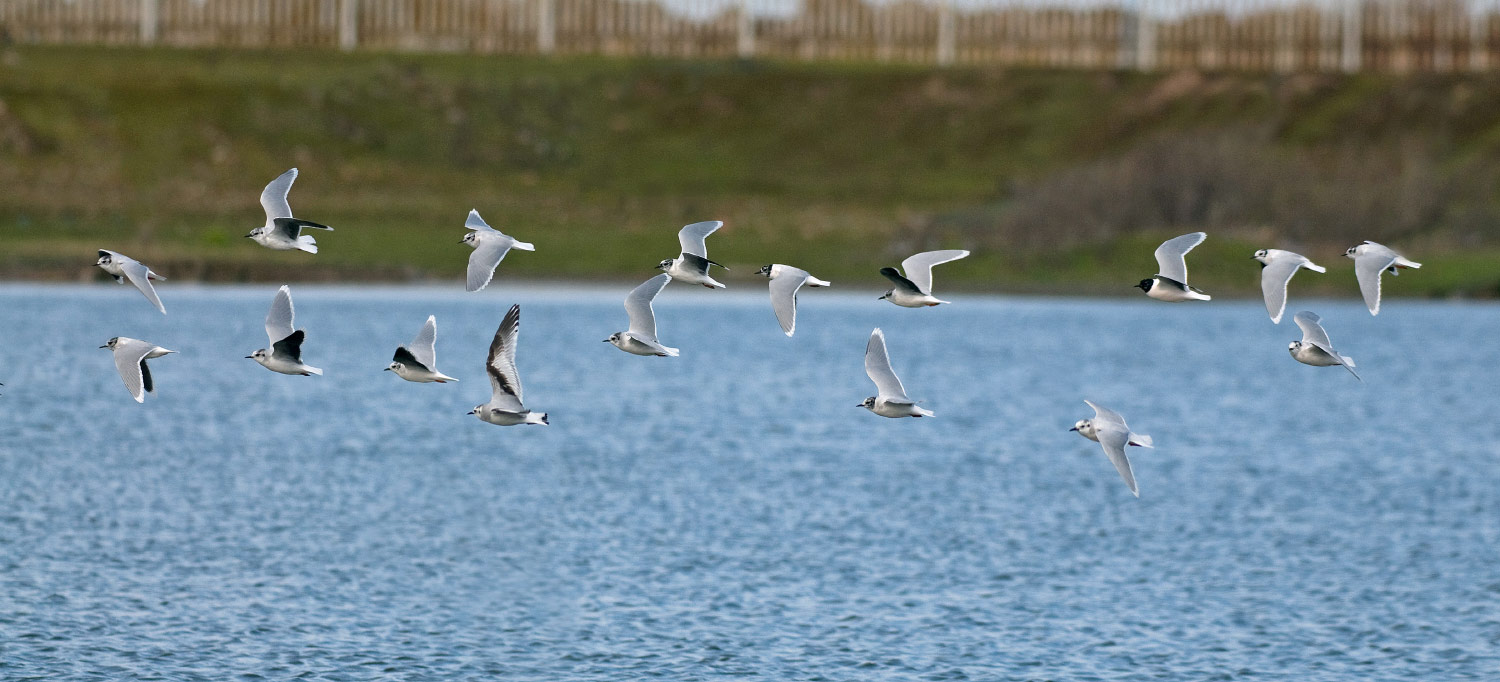
Little Gulls (Seaforth, Lancashire, 15 April 2008). This spring flock of Little Gulls demonstrates a typical variation in hood development, with one already fully black but almost all the others still with winter-type patterns. The sole first-winter bird (seventh from the left) is easily discernible by its distinctive upperwing pattern and black tail band (Steve Young / www.birdsonfilm.com).
Little Gull
This species breeds colonially in freshwater marshes across Eurasia, where it can be quite common, and in North America, where it is rare and localised. Despite several previous attempts, Little Gull only bred successfully in Britain for the first time in 2016, when two youngsters fledged in Aberdeenshire. Though not a regular breeder here, non-breeding immatures can routinely be found across Britain and Ireland during the summer months, particularly in eastern areas, where they tend to be most numerous.
It is more pelagic in nature during winter, with Western Palearctic populations frequenting the Atlantic coasts of western Europe and the Mediterranean, as well as the Black and Caspian Seas. During this season, the birds are most often encountered in Britain and Ireland when forced close inshore by inclement weather conditions.
Little Gulls are best seen in Britain and Ireland when on migration. Large numbers pass through on their way to and from breeding grounds in northern Europe, and they can routinely be found at inland waterbodies as birds take shortcuts across land. In spring, east or south-east winds from mid-March to mid-May can produce good passage across southern England and the Midlands, especially if this airflow occurs in conjunction with precipitation, which forces birds to temporarily halt their movements. At this time of year, particularly in late April and May, adults will be at their resplendent best, making them a sight to treasure.
Return migration is somewhat more protracted, with the first returning adults joining non-breeding immatures from July and passage continuing well into the autumn.
As with other gulls, Little Gulls are quite site loyal, returning to the same staging grounds year after year. Until very recently, Seaforth Nature Reserve, Lancashire, would hold big flocks annually from late March to May, although a change in food availability means they now gather off Hoylake and Leasowe, Cheshire. In summer and early autumn, Hornsea Mere, East Yorkshire, ranks as Britain's top site for the species. Numbers increase from the beginning of July, peaking later that month and in August, when several thousand can be present; for example, 7,800 were counted on 9 August 2017. Several other staging sites attract good numbers at this time, including Arbroath, Angus, which regularly produces counts of up to several hundred in August.
Little Gull is the world's smallest gull and also one of its most beautiful. The buoyant flight action gives it a tern-like elegance when airborne, though its rounded wing profile gives it a quite distinctive look on the wing, particularly when considering the more angular wing tips of many other small gulls (and terns). At rest, they can look comically small if alongside other species, such as Black-headed Gull, with a short-legged and almost dumpy 'jizz'.
Adults exhibit a strikingly dark underwing which, coupled with its contrasting broad, white trailing edge, is unique among Europe's small gulls. This, combined with the white tips to the primaries and paddle-shaped wings, generally makes identification straightforward. At rest, the legs are obviously short and red, being brightest during the breeding season. In summer (April-July), a complete black hood is attained. The bill is black.
Immatures can superficially resemble several other species of small gull. When seen in flight, second-calendar-year birds exhibit a strong, unbroken 'W' pattern on the upperwing, formed by a solid brownish-black 'bar' across the median coverts and largely brownish-black primary coverts and outer primaries. In contrast to older birds, the underwing is usually very white. The presence of a black tail band is variable dependent on the state of moult, but it is generally broken by spring. The legs are usually a varying shade of red and the bill is black.
Black-headed Gull
Despite the obvious size differences, Black-headed Gulls – particularly immatures – can pose identification challenges. In second-calendar-year birds, there are several differences in the upperwing, with a less distinct median covert bar and considerably more white in the primaries and primary coverts, meaning the upperwing generally looks greyer and less dark than in Little Gull. The underside of the primaries show a 'shadow' of mid-grey, thus looking less clean than the white of immature Little Gull.
Structurally, Black-headed Gulls are longer legged and longer billed, the latter varying from a mid-orange (with dark tip) to deep reddish in colour, depending on the season. At all ages, any summer-plumaged Black-headed Gull exhibits a dark brown (not black) hood, with an obvious white eyering – which Little Gull lacks.
Structurally, Black-headed Gulls are longer legged and longer billed, the latter varying from a mid-orange (with dark tip) to deep reddish in colour, depending on the season. At all ages, any summer-plumaged Black-headed Gull exhibits a dark brown (not black) hood, with an obvious white eyering – which Little Gull lacks.
Bonaparte's Gull
In terms of size and structure, North America's Bonaparte's Gull is a 'halfway house' between Black-headed and Little Gulls, with some plumage features also intermediate. Breeding adults exhibit a black hood, although have an obvious white eyering. At all ages, the underwing is a clean white, making it easy to separate from adult Little Gull – but less so from immatures. The bill is black and the legs pale pink, this flushing to a salmon-pink in breeding adults.
In flight, the upperwing pattern on immature Bonaparte's looks neat, clean and delicately constructed. Although the median covert bar is quite distinct, it never approaches the broad, bold pattern seen in Little Gull. A neat, dark trailing edge is formed by the black tips to the primaries and secondaries, a pattern not seen in Little Gull.
- For more on separating Black-headed and Bonaparte's Gulls see Birdwatch 273: 45-52.
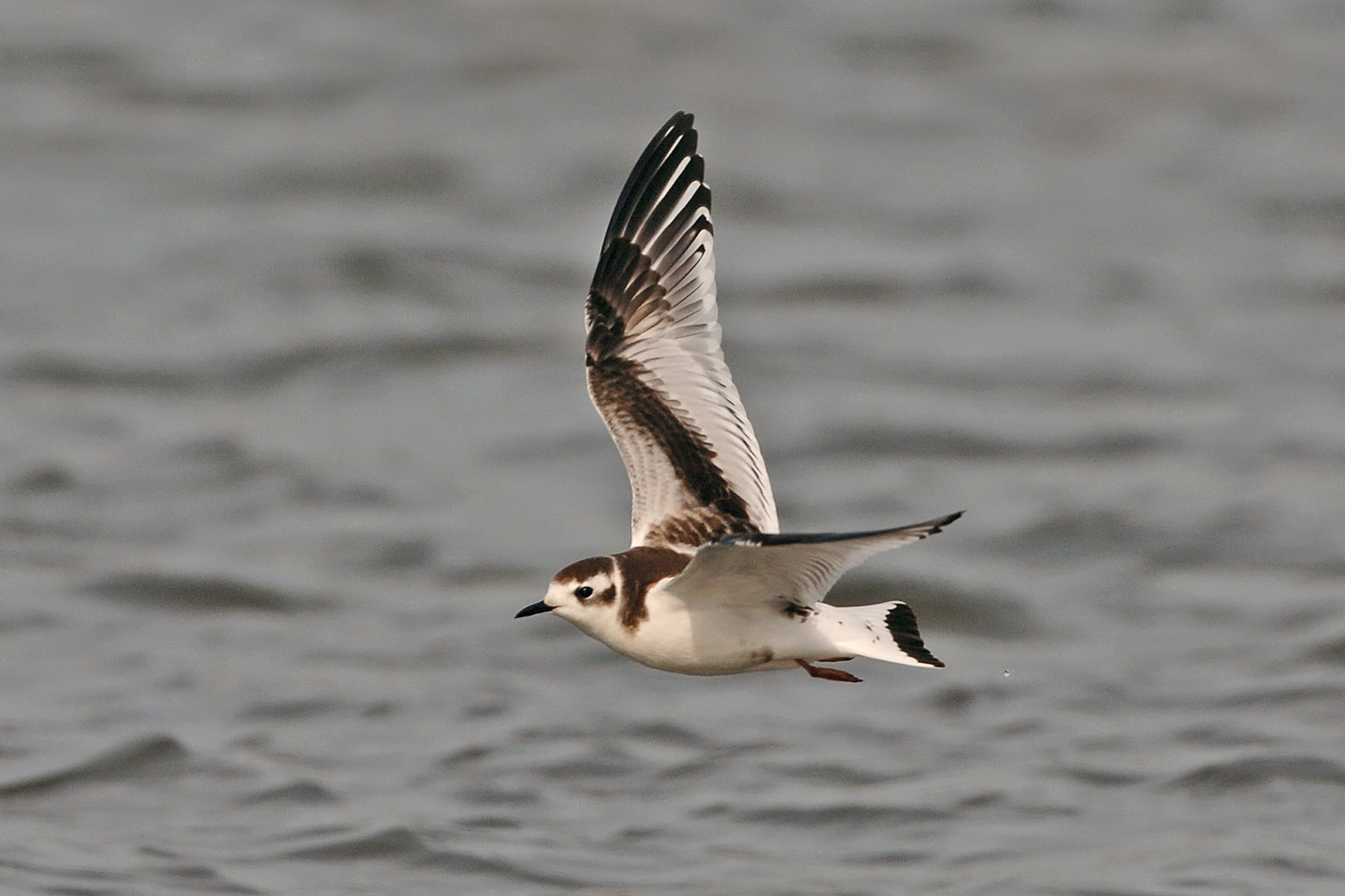
Juvenile Little Gull (Crosby, Lancashire, 11 September 2005). Little Gull is compact and dainty, with a rather short, fine bill. As well as the dark brown median-covert bar and primary coverts, and extensively dark outer primaries, juvenile plumage exhibits variable chocolate-brown mantle and scapular feathering, with this also extending onto the neck and cap. Note how white the underwing is at this age (Steve Young / www.birdsonfilm.com).
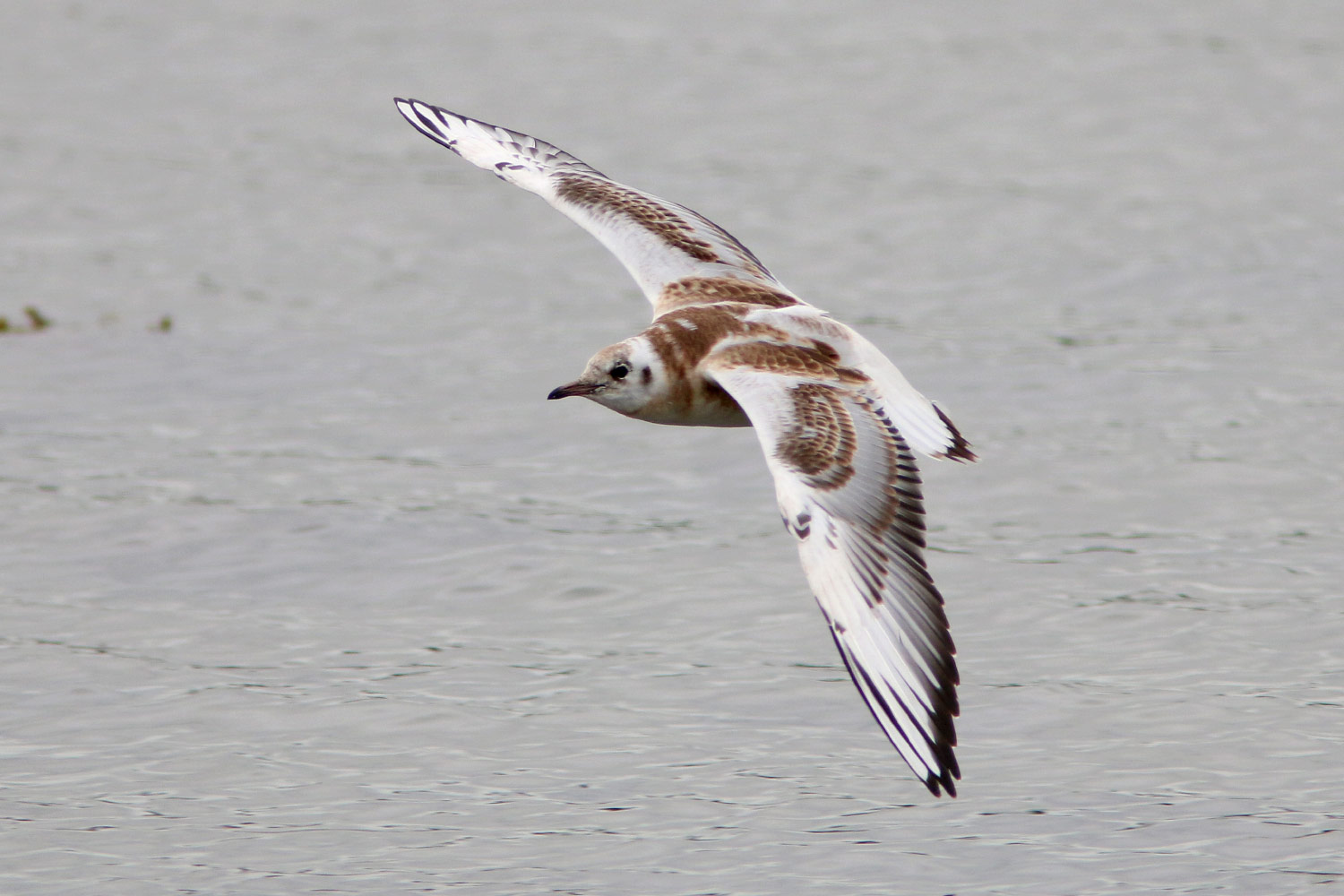
Juvenile Black-headed Gull (Seton Burn, Lothian, 21 July 2014). Compared to Little Gull, this juvenile Black-headed looks a bigger, less agile bird, with a longer, bicoloured bill and more robust structure overall. The juvenile feathering is more of a 'tortoiseshell' colour, while the median-covert bar is comparatively weak looking, with the outer primaries largely white (Dominic Mitchell /www.birdingetc.com).
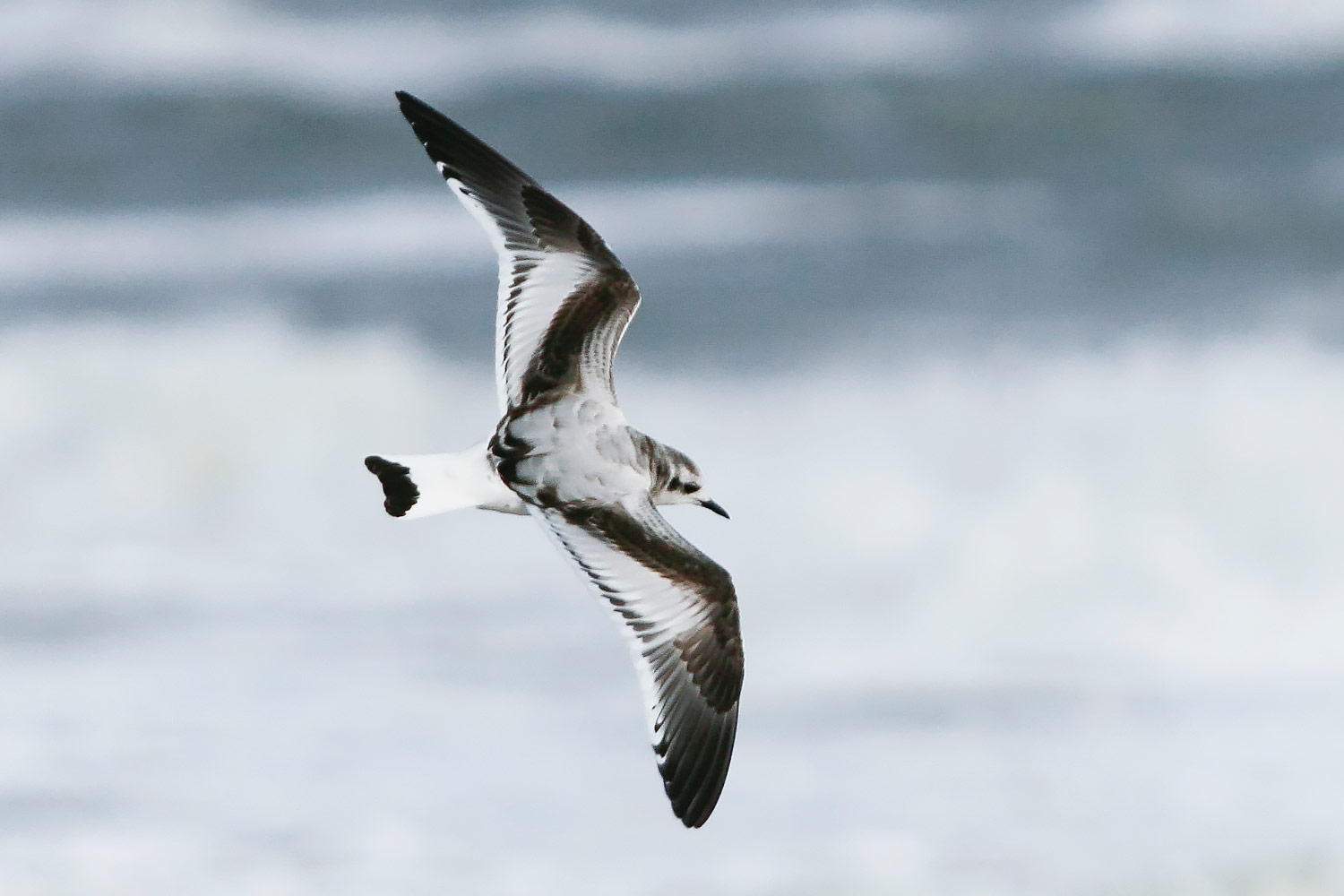
First-winter Little Gull (Sylt, Germany, 13 November 2006). This image perfectly illustrates the strong 'W' pattern that characterises first-year Little Gull. Note the grey scapulars and saddle, indicating a bird that has undergone post-juvenile moult (Ralph Martin / www.agami.nl).
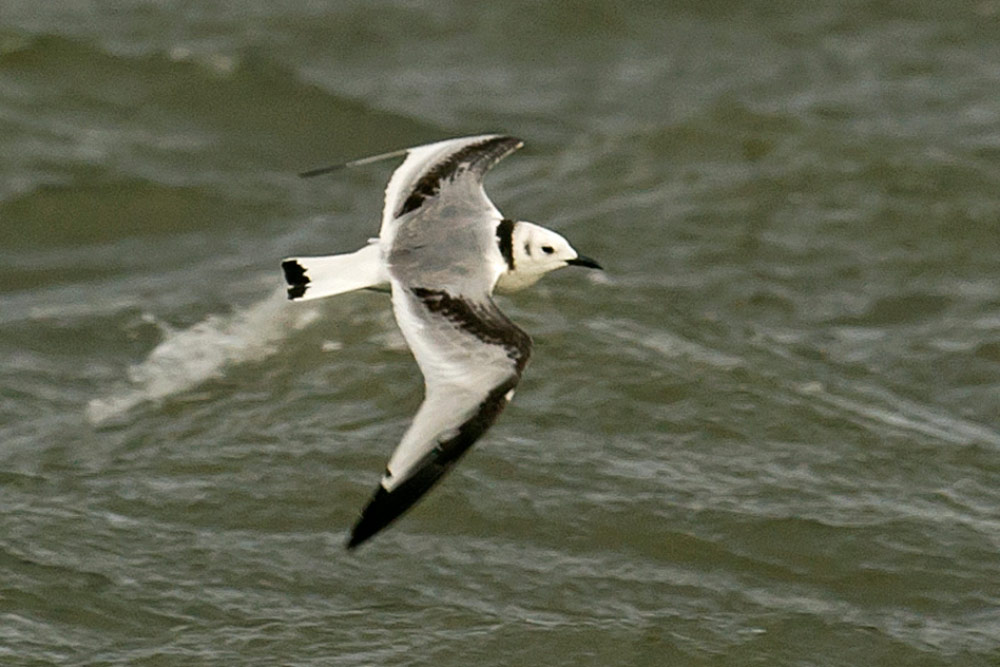
First-winter Kittiwake (Seaforth, Lancashire, 3 January 2012). First-winter Kittiwake is a potential pitfall for first-winter Little Gull, but it appears larger and more rangy in structure, while the 'W' pattern is more restricted and neater, with an obvious white trailing edge to the wing. There is also a distinct black marking on the nape, which is lacking in Little Gull (Steve Young /www.birdsonfilm.com).
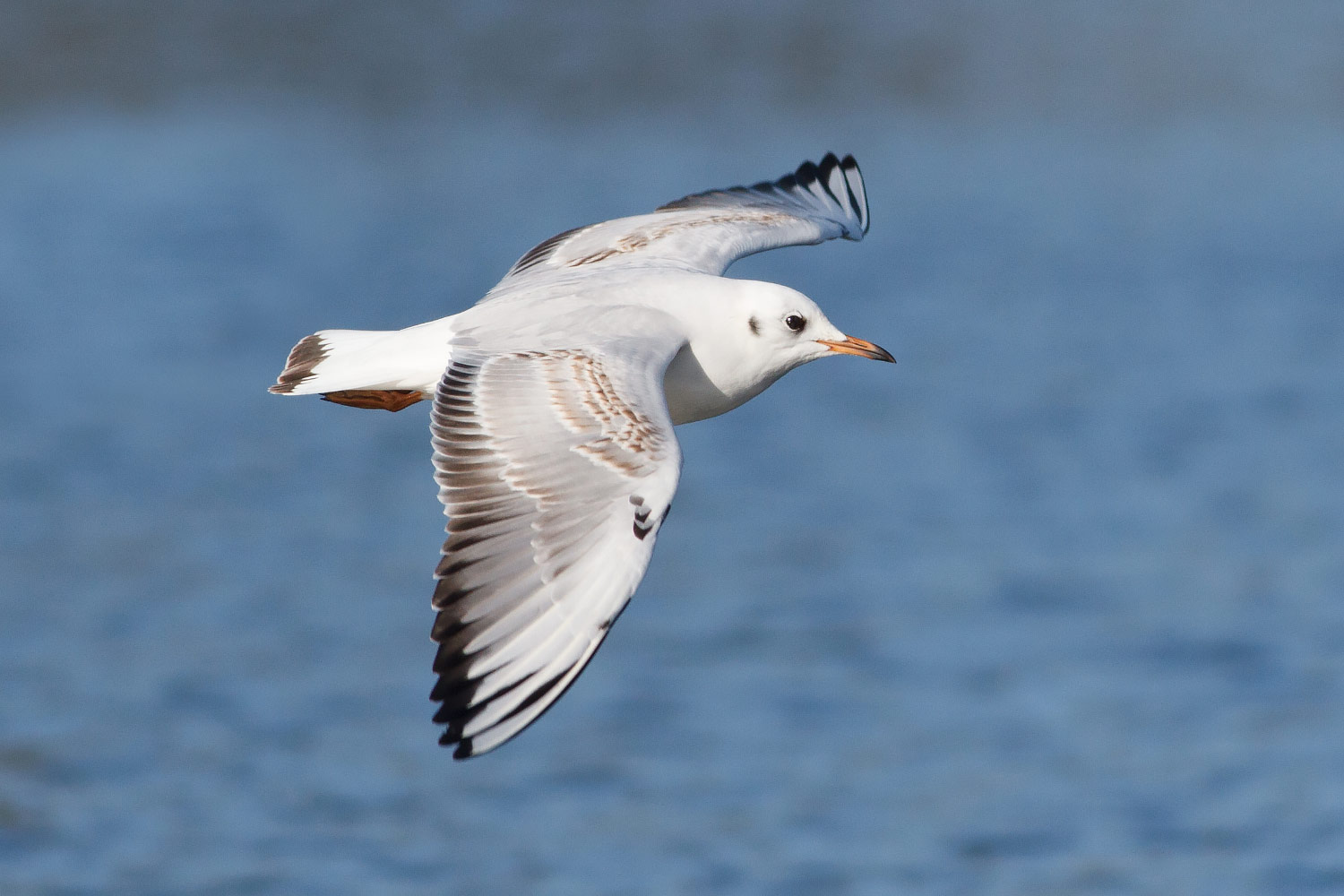
First-winter Black-headed Gull (Hyde Park, London, 30 January 2015). This perfectly illustrates how grey and uniform the upperparts of many first-winter Black-headed Gulls can look, with the faintest brown markings on the median coverts and a largely white – rather than black – outer primaries (although some are more extensively dark). Other features include the pale, dark-tipped bill, and broad, indistinct trailing edge to the wing (Josh Jones / www.joshrjones.com).
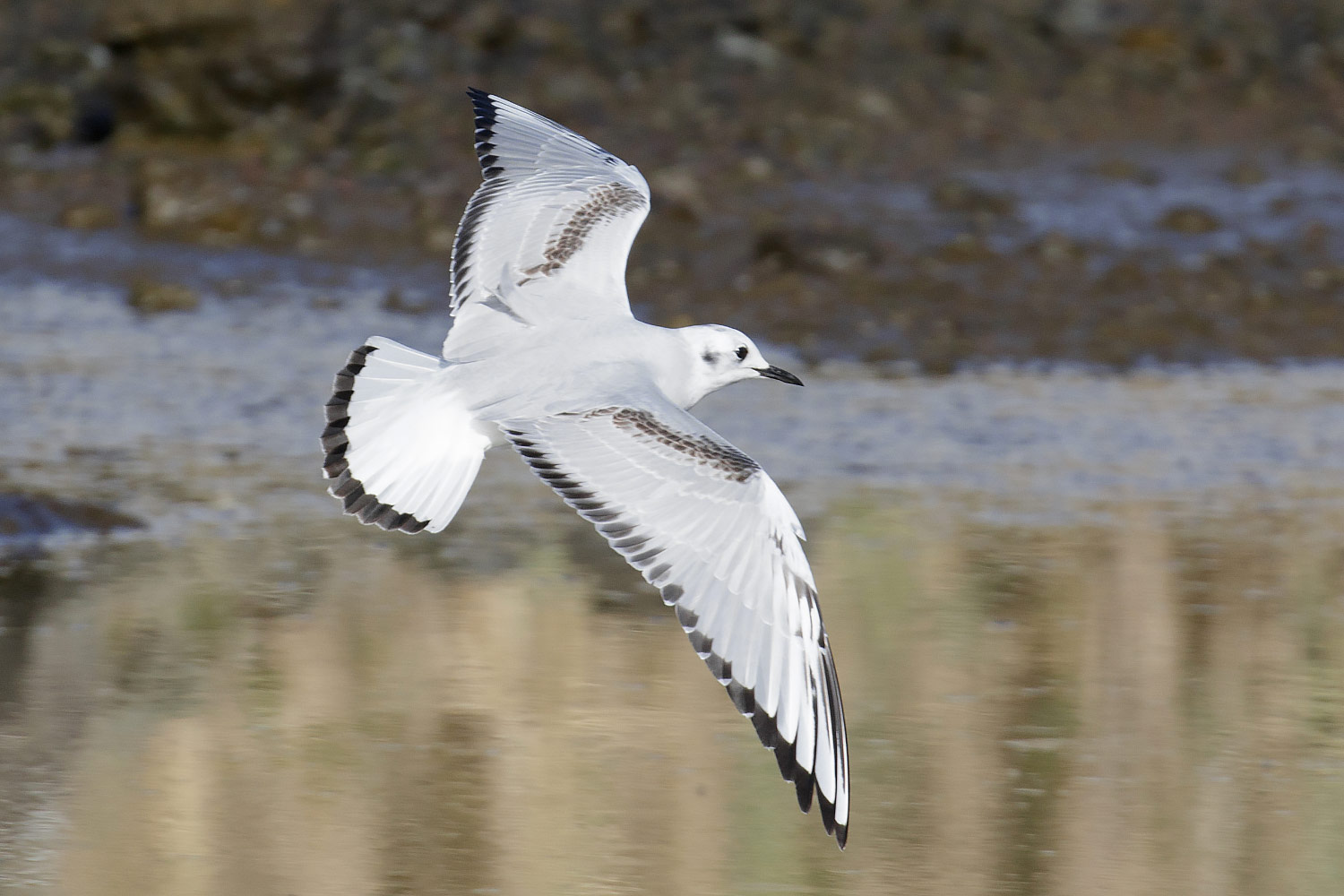
First-winter Bonaparte's Gull (Terceira, Azores, 17 February 2018). As in Black-headed, the upperparts of Bonaparte's are much cleaner than in Little Gull, with weaker markings and more grey overall. The markings on the median-covert bar are a darker brown than in Black-headed Gull and the species always shows a crisp, dark trailing edge to the wing. Note also the black bill, as in Little Gull (Josh Jones / www.joshrjones.com).
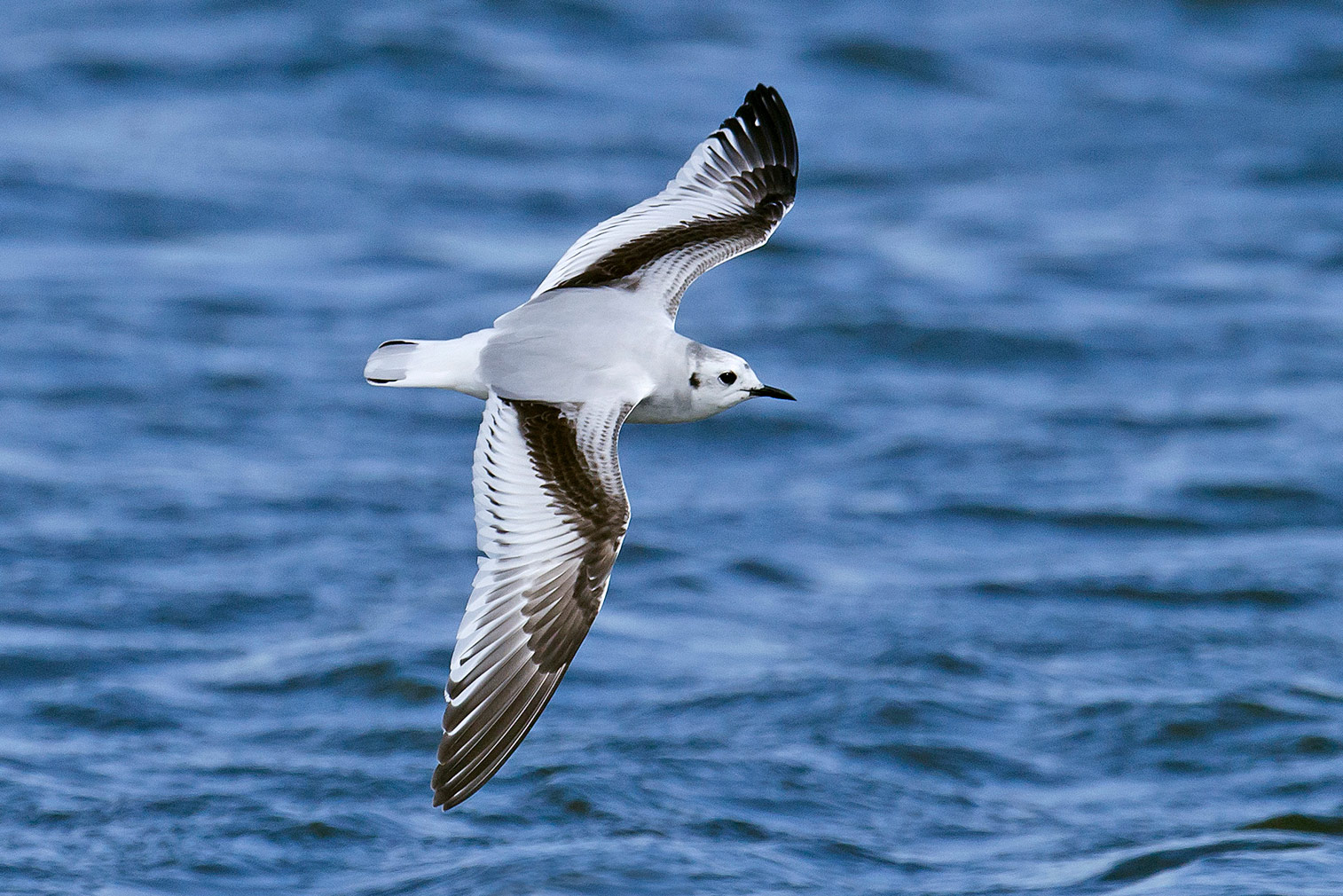
First-summer Little Gull (Seaforth, Lancashire, 17 April 2012). While this spring bird doesn't show any hint of a summer hood, one of the clues that this is a later-season individual is the moulted tail feathers, which are an adult-like all-white (Steve Young / www.birdsonfilm.com).
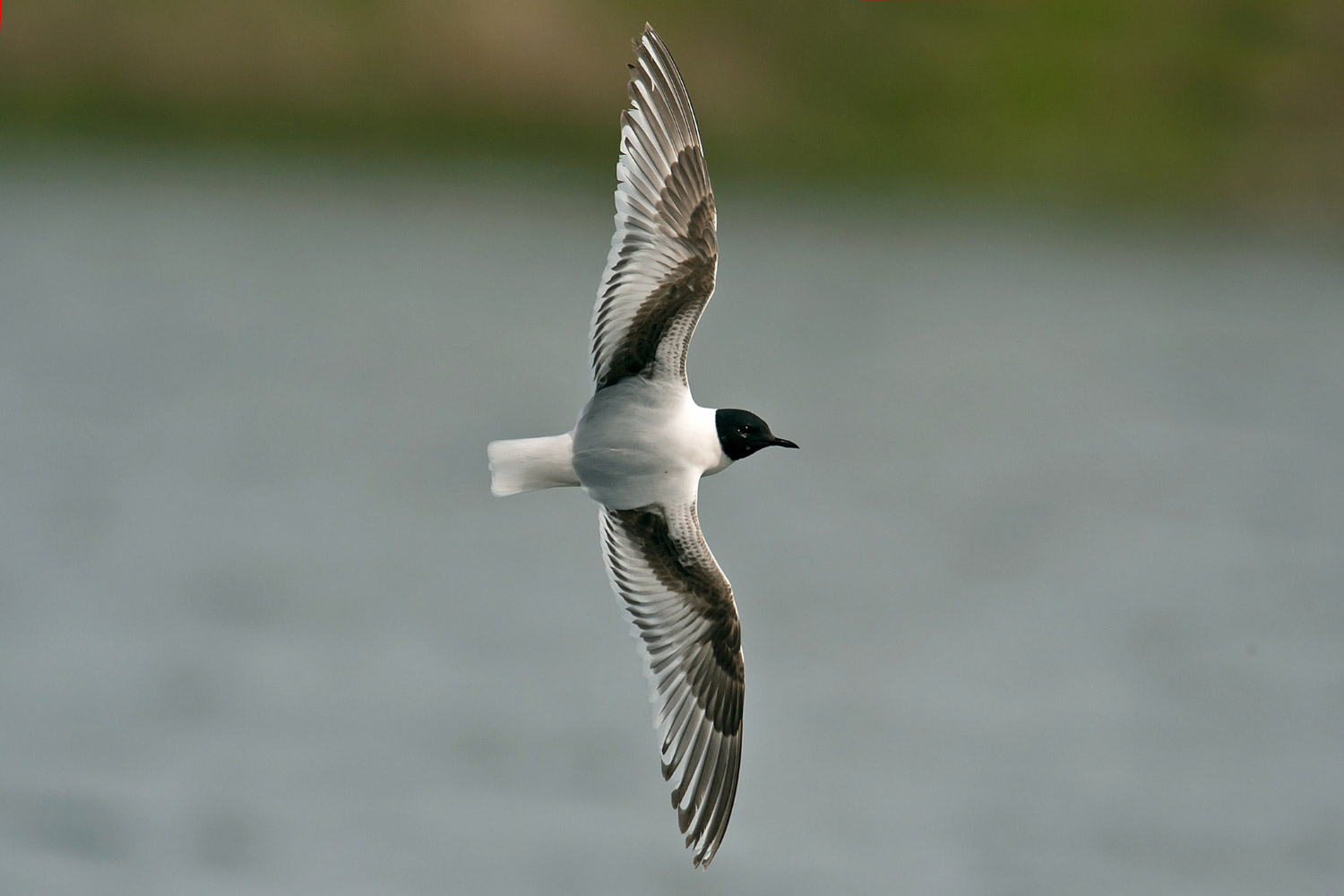
First-summer Little Gull (Seaforth, Lancashire, 8 May 2012). This individual is instantly recognisable as a first-summer bird, with a full black hood and a fully moulted tail. However, it is clearly not older than its second calendar year as it retains the juvenile-like upperwing pattern (Steve Young / www.birdsonfilm.com).
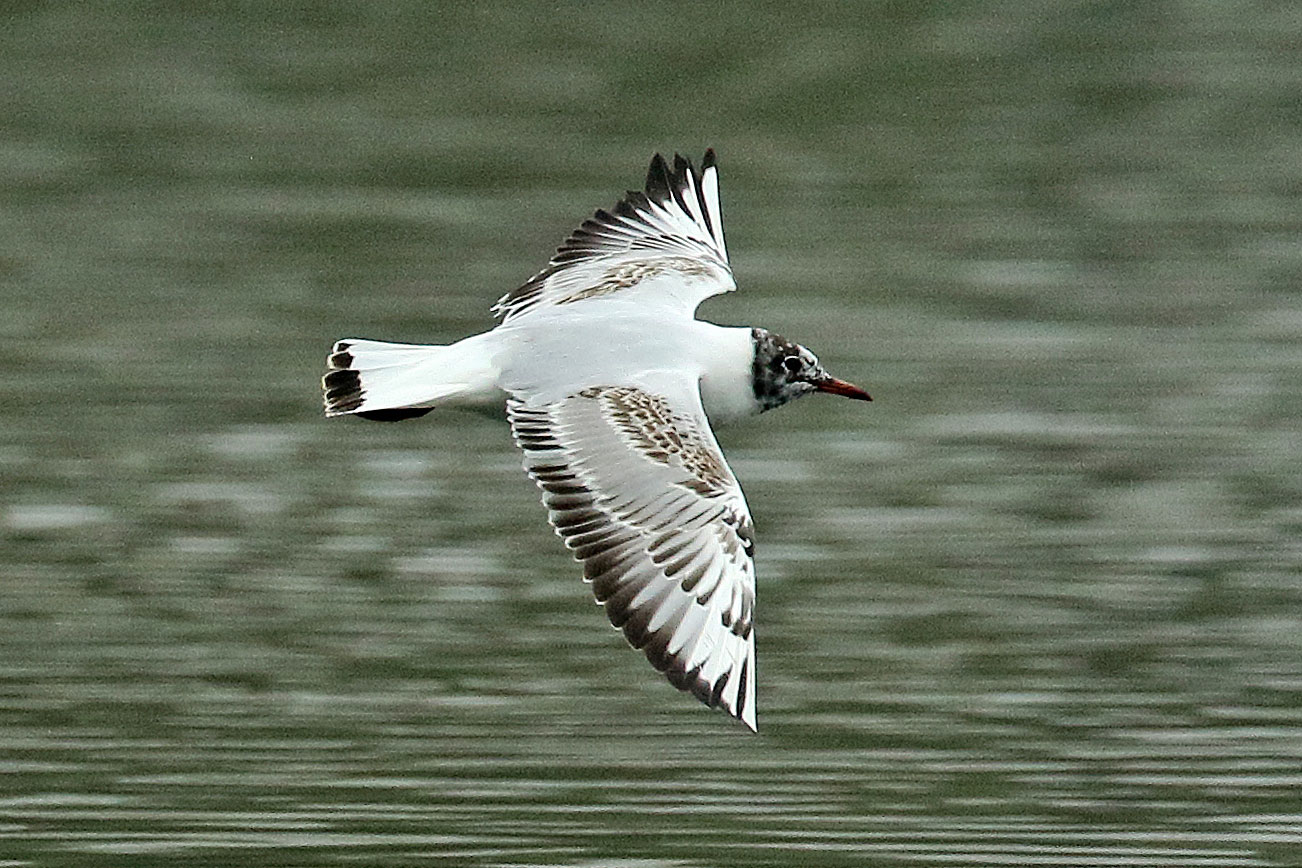
First-summer Black-headed Gull (Ponders End Lake, London, 8 April 2018). This Black-headed is developing a brown summer hood, though only in a minority does this become complete, and some retain 'winter' heads in their first summer. Note the long, reddish bill and upperwing pattern: a faint mid-brown median-covert bar and broad, indistinct dark trailing edge, which make it readily separable from Little and Bonaparte's Gulls of the same age (Dominic Mitchell / www.birdingetc.com).
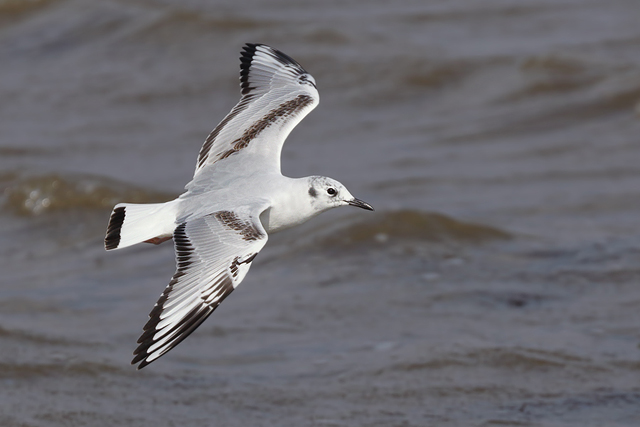
First-summer Bonaparte's Gull (Hengistbury Head, Dorset, 3 May 2017). Bonaparte's Gull tends not to display much of a hood in its first-summer plumage, instead retaining a winter-type hood or, at most, black speckling around the head, as in this bird. Note the neat brown median covert bar and black trailing edge to the wing. This bird appears to have quite extensively dark outer primaries, although the overall strength of the upperwing pattern still falls well short of typical Little Gull (Joe Murphy).
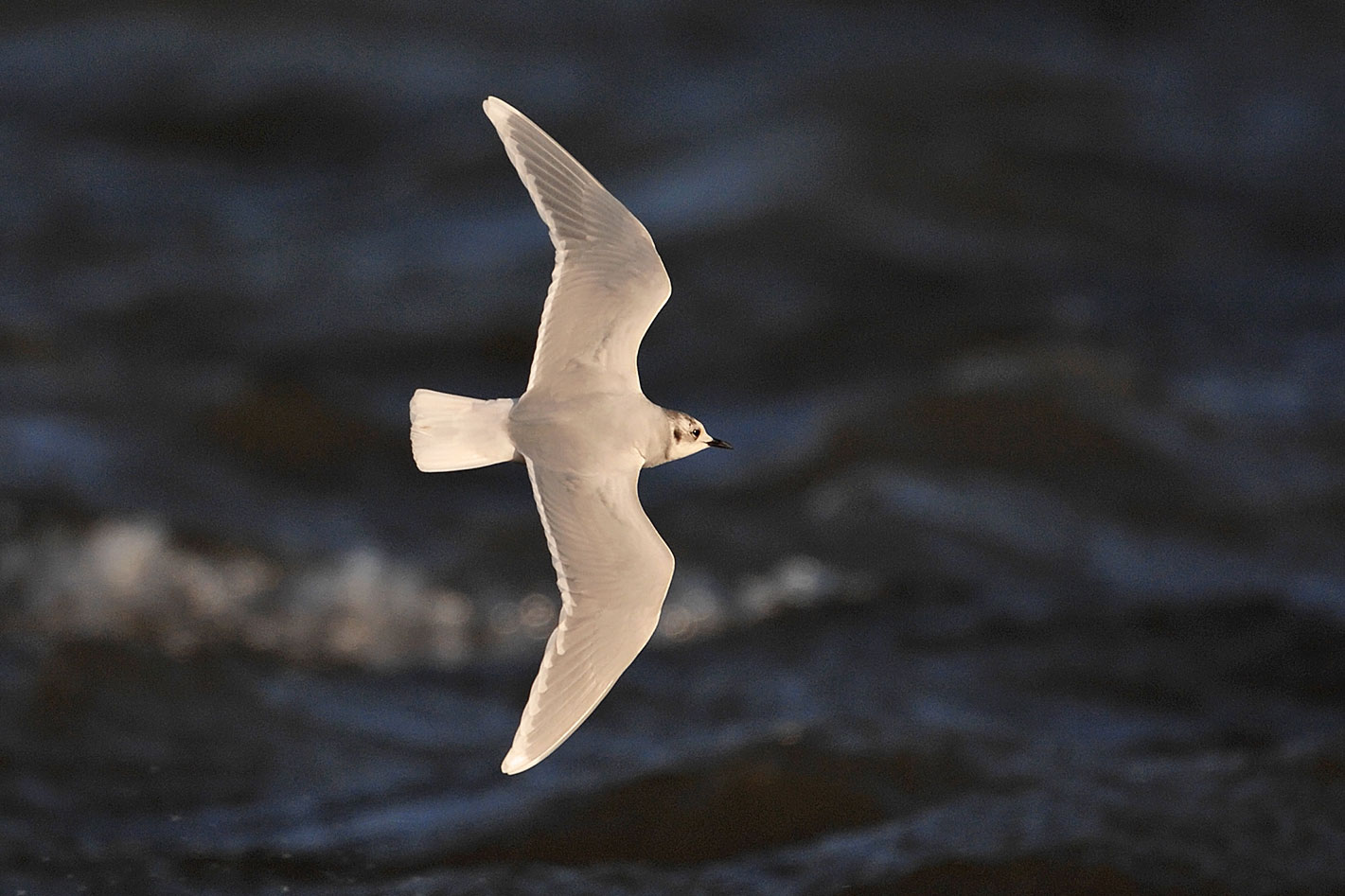
Adult winter Little Gull (Seaforth, Lancashire, 20 January 2007). Adult Little Gull shows a distinctive upperwing pattern, with a neatly contrasting white trailing edge to the primaries and secondaries, which becomes broadest at the outer primary tips. Note also the small, dark bill and distinctive wing shape, with rather blunt-tipped primaries (Steve Young / www.birdsonfilm.com).
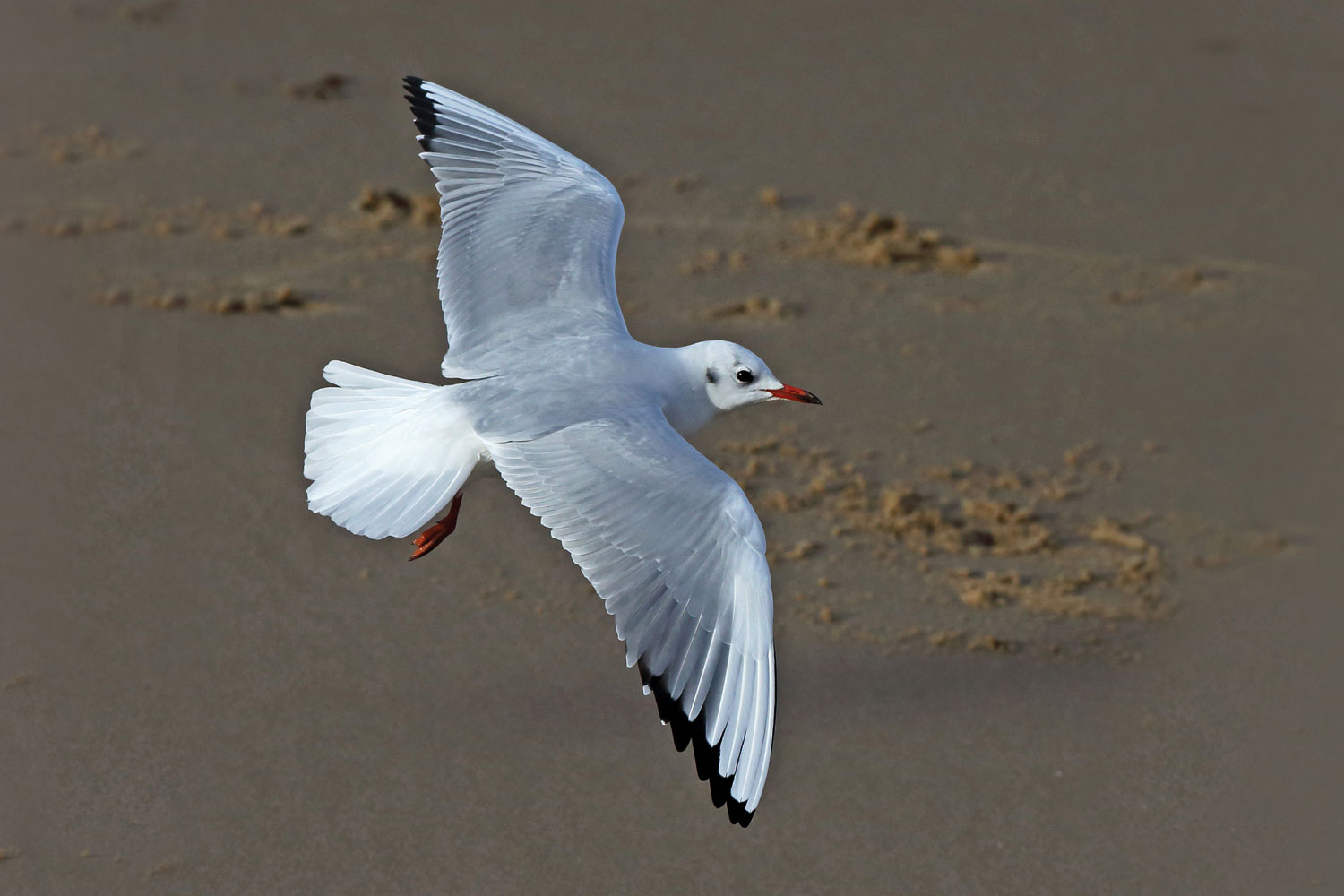
Adult winter Black-headed Gull (Walcott, Norfolk, 13 November 2012). The upperwing pattern of adult Black-headed Gull contrasts considerably with Little Gull, with a broad, white wedge extending along the outer primary coverts and primaries and a neat, black trailing edge to the latter. It lacks the distinct, contrasting white trailing edge along the secondaries, as in Little Gull (Neil Bowman).
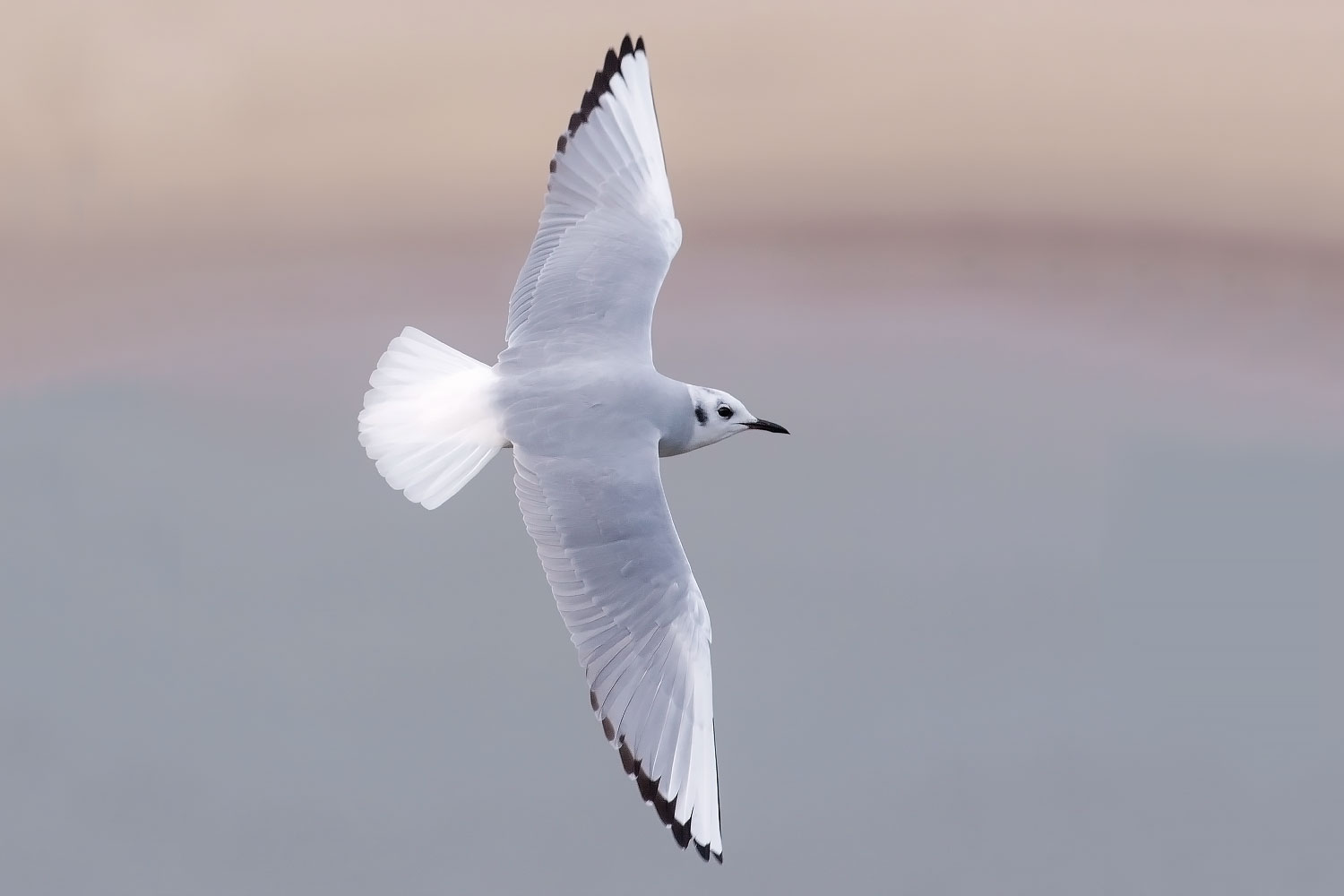
Adult winter Bonaparte's Gull (Galicia, Spain, 1 February 2015). Adult Bonaparte's Gull has an upperwing pattern superficially similar to Black-headed, rather than Little, with the white 'wedge' on the outer primaries and the black trailing edge to the primaries. However, note the black bill (Pablo Gutiérrez).
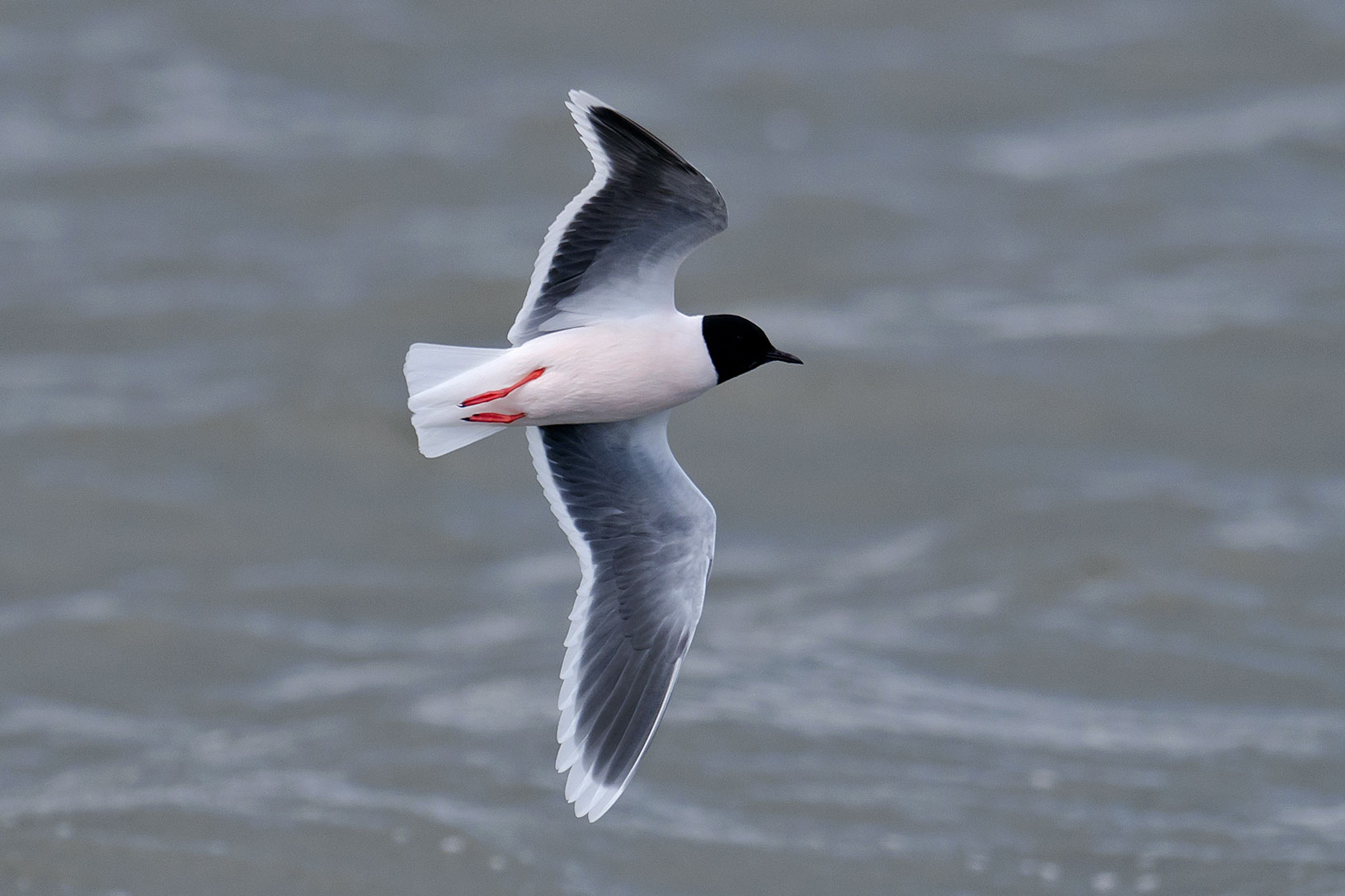
Adult summer Little Gull (Seaforth, Lancashire, 17 April 2012). If the upperwing pattern of adult Little Gull was distinctive, then the underwing pattern is even more so. Appearing dark in most lights, even when well lit, the largely dark underwing contrasts neatly with the white trailing edge. Note also the relatively broad, rounded wing shape, quite unlike Black-headed and Bonaparte's Gulls (Steve Young / www.birdsonfilm.com).
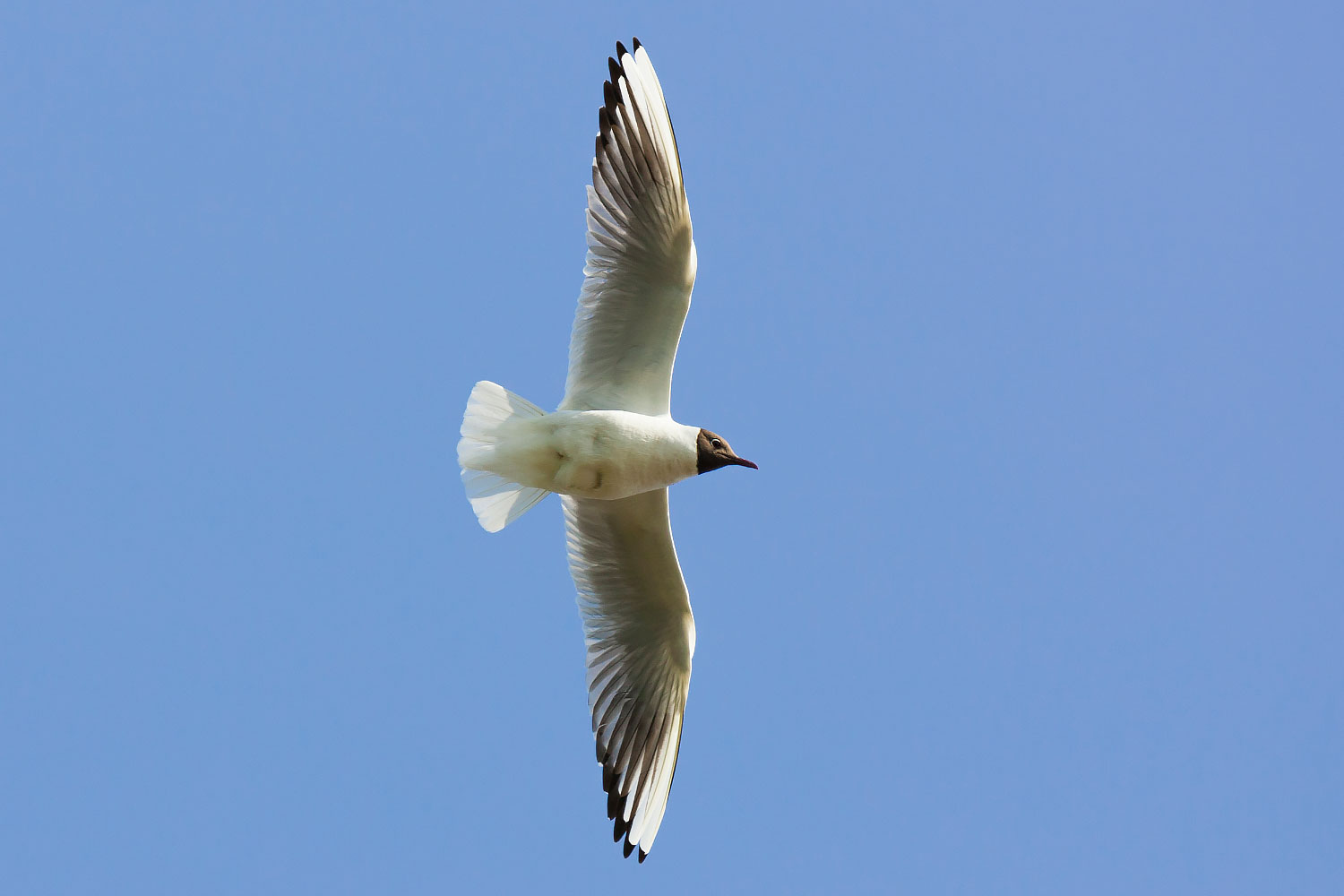
Adult summer Black-headed Gull (Oksky, Russia, 17 May 2006). Even when well-lit from above, this Black-headed Gull's underwing looks a little messy, being pale and darkening towards the inner primaries, before becoming quite white again on the outer primaries. The hood is brown, rather than black (Oliver Smart).
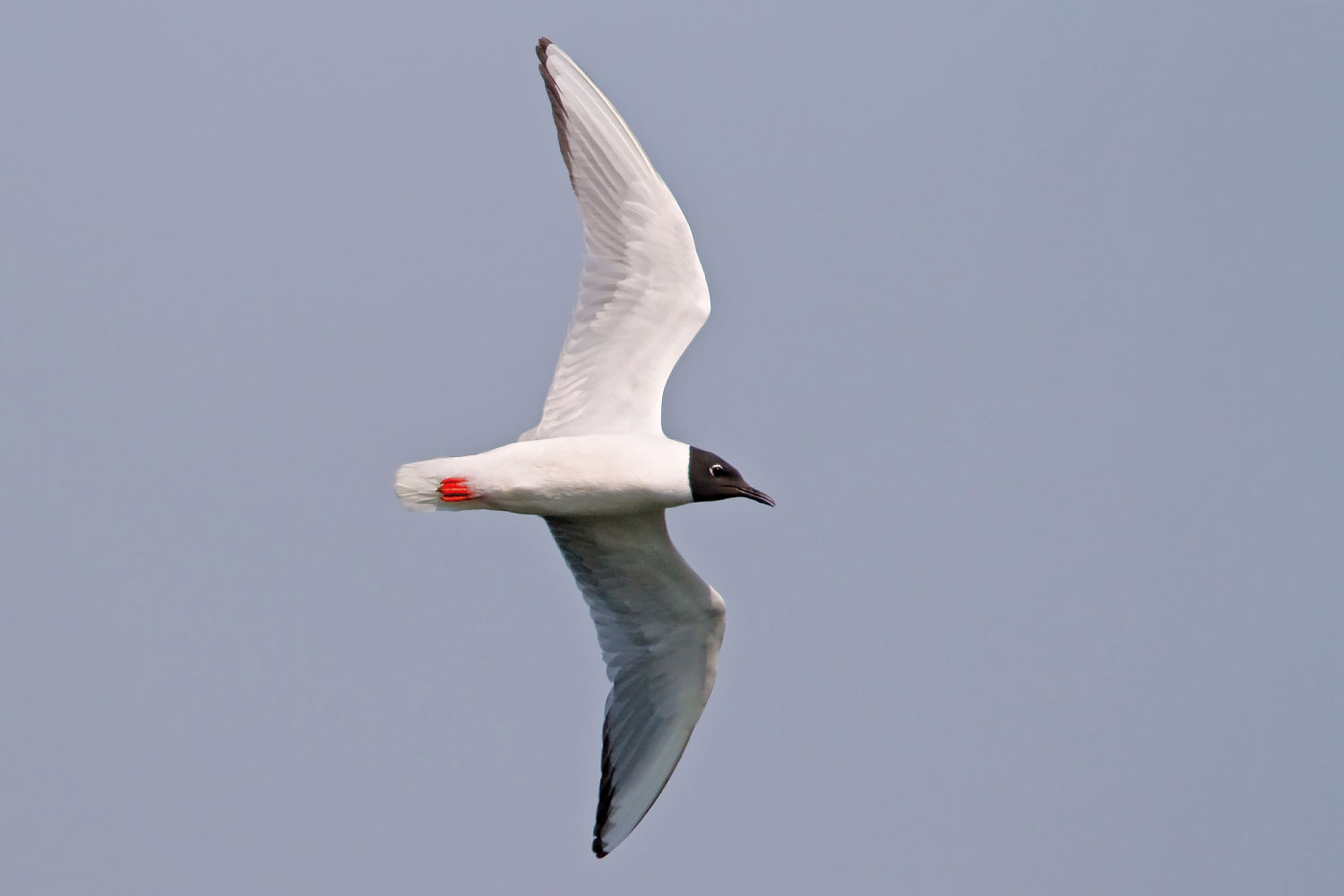
Adult summer Bonaparte's Gull (Manitoba, Canada, 14 June 2006). In total contrast to Little Gull, the underwing of adult Bonaparte's is a clean Persil white, with the faint dark trailing edge to the primaries the only exception. The hood of this summer adult is charcoal-grey, rather than black, and note the obvious white eyelids (Glenn Bartley / www.agami.nl).
Confirmed breeding of Golden Nightjar in Western Sahara
Back in May 2015 a Golden Nightjar was hit by a car and killed along the now-famous road between Dakhla and Aousserd, then representing the first record of this species in Western Sahara. It showed indications of being a breeding bird, thus the idea sparked that there may be a remote and small population in Western Sahara. Whether the bird was a regular or just a phenomenon induced by favorable weather or feeding conditions was unknown at the time. The discovery of this truly stunning nightjar obviously excited birders, for it suddenly seemed possible to connect with this species while picking up other local goodies, such as Cricket Warbler and African Dunn's Lark.
Then, for three years running from 2016-18, Golden Nightjar was found at Oued Jenna, a wadi interspersed with some high-standing trees some 20 km north-west of Aousserd. The species was both heard and seen here by a number of visiting birders, making it a real possibility to connect with in Western Sahara. However, the status of the species remained unclear: while there were indications of breeding, it couldn't be proven as eggs or juveniles were never observed. In the meantime, the first confirmed breeding record of Golden Nightjar for the Western Palearctic came in April 2018, when a nest with a single egg was found in northern Mauritania.
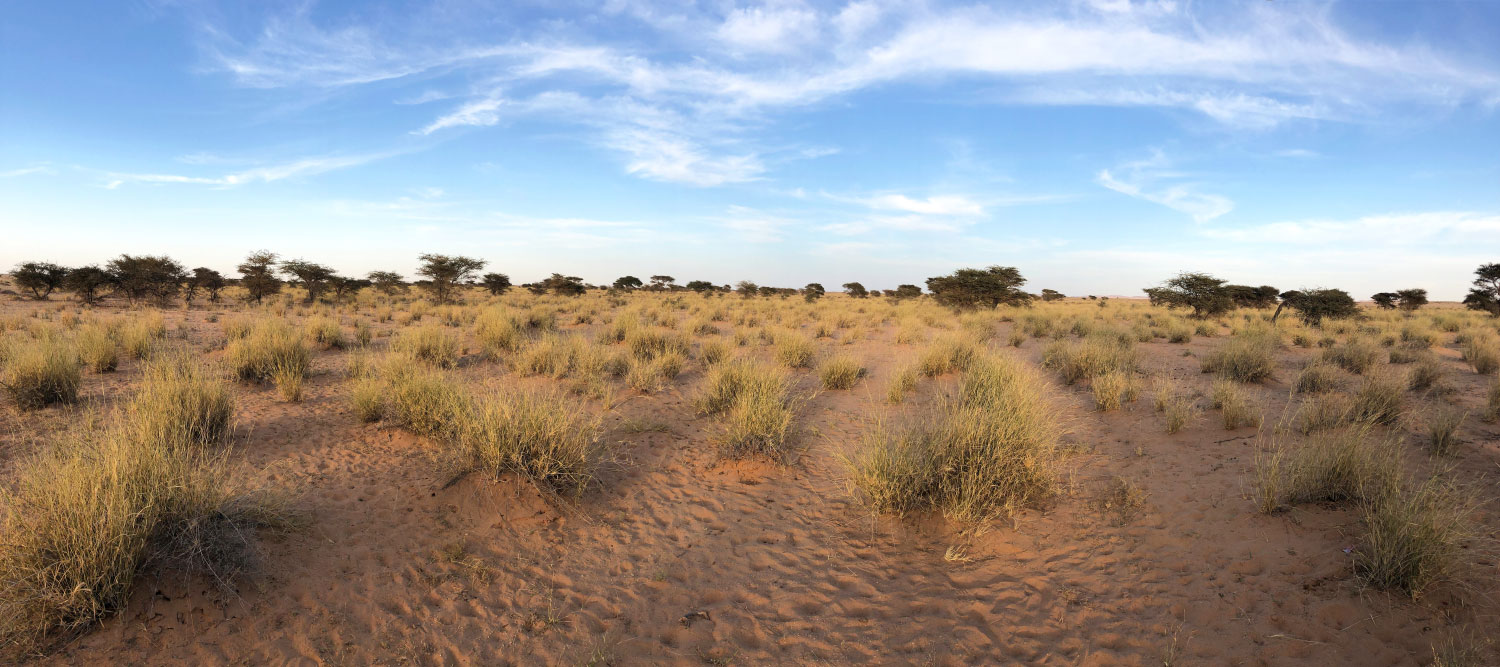
Typical Golden Nightjar breeding habitat in Western Sahara (Felix Timmermann).
I started planning a four-week stay in Morocco and Western Sahara in late 2018. It was my intention to drive into Western Sahara alone and try to connect with the targeted species. While the larks and other 'headline' birds seemed pretty straightforward, the nightjar required some positive thinking. By the time I arrived in Dakhla, no-one had yet seen the species at Oued Jenna in 2019 – this having been the only known location for it along the road towards Aousserd. I spent some days and nights fruitlessly searching and listening in the area, which was very dry and desolate this year. At that point, it seemed very unlikely that I was going to connect with the nightjar on my trip.
At noon on 19 March I came upon a group of German birdwatchers, who had been using a guide to maximize their chance of connecting with all specialties. While watching Black-crowned Sparrow and Dunn's Larks, they showed me photos of a bird they'd seen the previous night – it was indeed a Golden Nightjar, and with it were two chicks!
Excitement rushed through me, for suddenly it felt like I might see my main target after all, but this was quickly followed by disappointment – the site was in the middle of the desert some 40 km off the main Aousserd road. The location, which was provided by their guide from Gayuin Birding Tours, was clearly never going to agree with a two-wheel drive rental car – that was obvious even from Google Maps. I thanked the group for the information and left towards Aousserd.
The saying "go big or stay home" came to mind and temptation drew me off road and into the desert. I lost the phone connection after 5 km, scratched the car badly and finally couldn't continue past the 15 km point. Deciding that it simply couldn't be done with my car, I headed back and planned to ask around Aousserd until someone agreed to take me there. Halfway back to the road, I saw the oldest and coolest Land Rover I'd ever seen. There were three guys having tea in the shade, so I stopped the car and walked towards them. Lucky for me, they spoke English and immediately agreed to take me to the site! I was elated beyond belief. We hid my car, two of them got on top and I was seated on the passenger seat for the next three bumpy hours. We only stopped for some camel milk and arrived at the GPS position at around 4 pm.
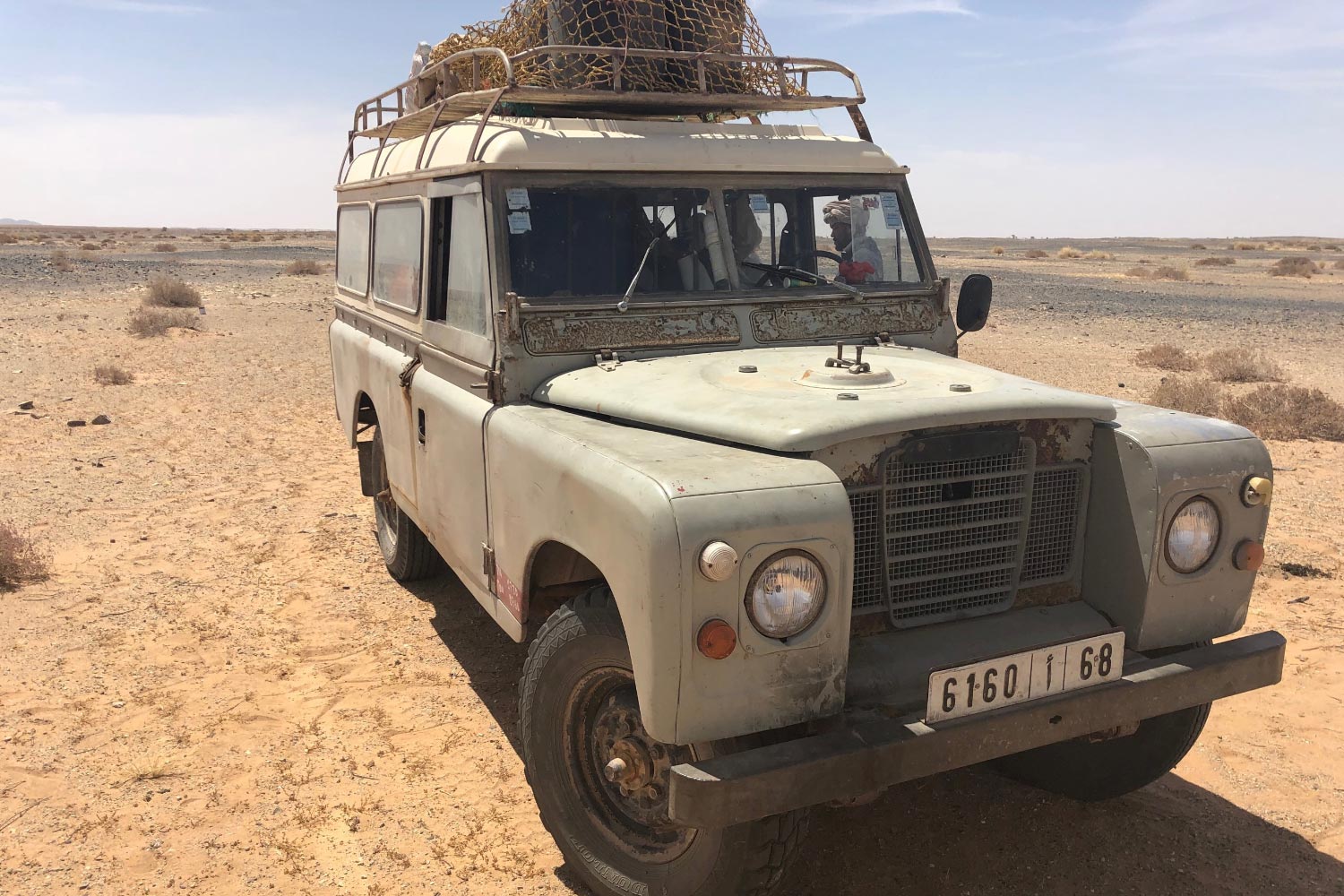
What a car to drive around the Sahara – reliability at its best!
While they set out to make a fire and prepare tea, I couldn't stop myself and headed into the wadi. It was much greener then Oued Jenna and had the usual birds: Desert Sparrows, Cricket Warblers, Fulvous Babbler and the odd Great Grey Shrike. Walking around carefully I scanned the trees trying to find those three that were standing close to each other, which was said to be nightjar location. After 10 minutes or so I became certain I was at the right spot, turned around and couldn't help but stare. There it was, sitting just 10 metres away – an adult Golden Nightjar roosting under a tiny patch of grass.
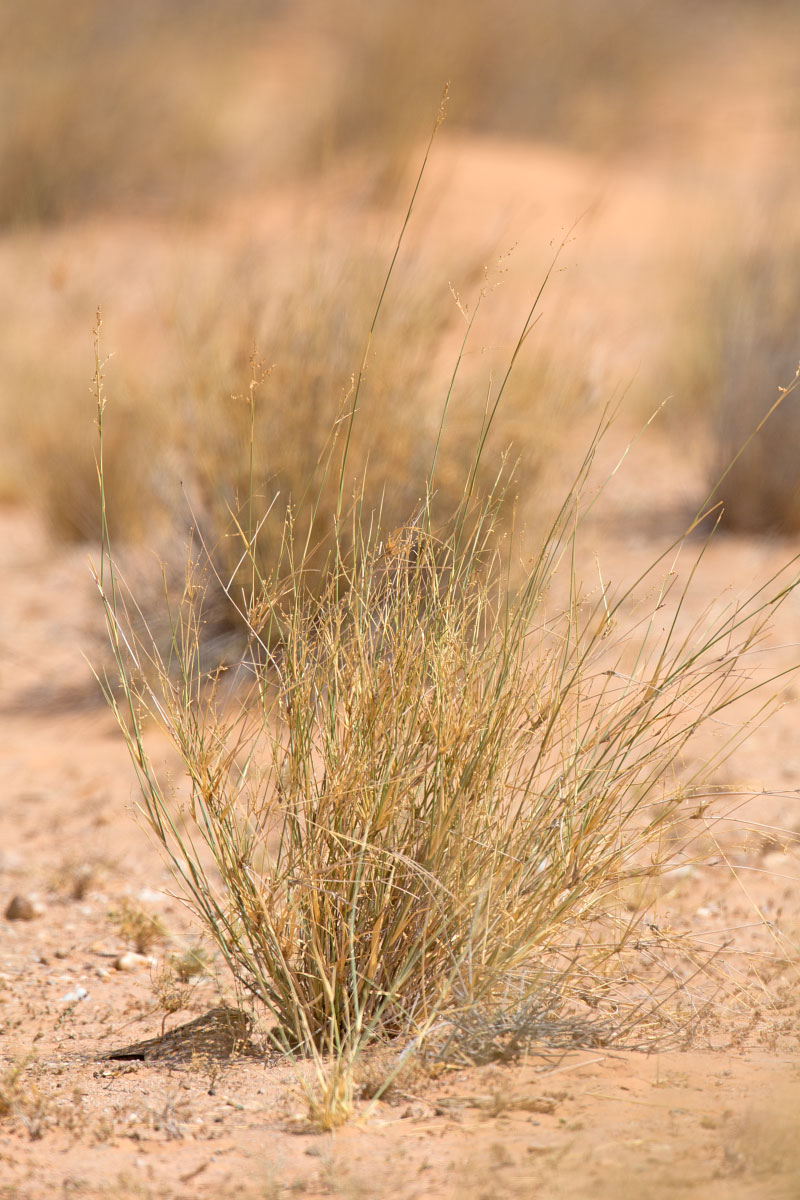
Female Golden Nightjar at roost in the afternoon heat (Felix Timmermann).
The chicks were sitting next to it in the sun, while the female was in the shade. I took some initial photos, admired the beautiful golden plumage and retreated in high spirits to some tea. I went back to the bird three times, leaving it alone for periods of at least an hour. Each time I went there, the chicks had shifted: sitting next to the female, right on the other side of the bush of grass and once under her wings. The roost was near trees of up to five metres in height, with sandy ground and interspersed grassy bushes.
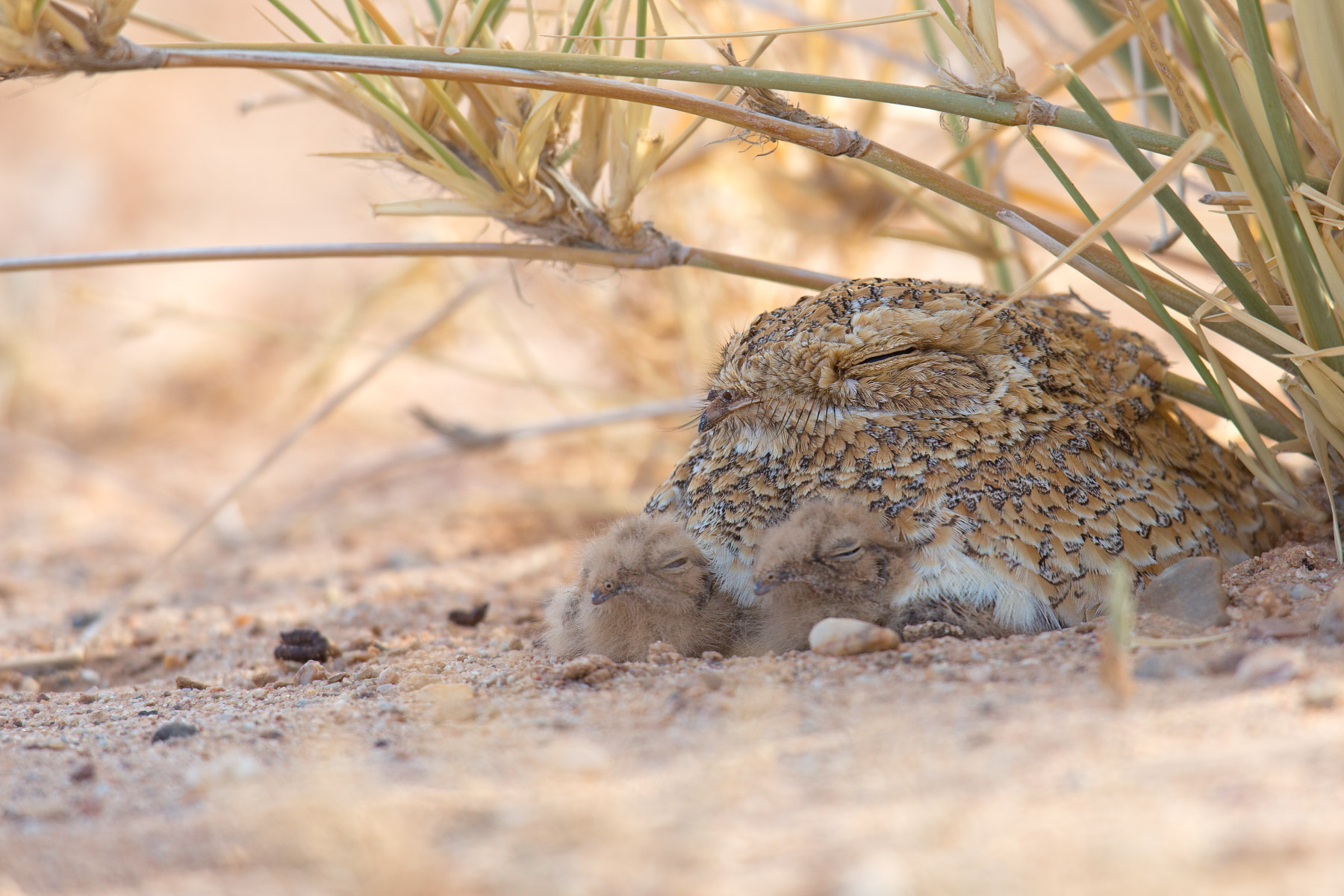
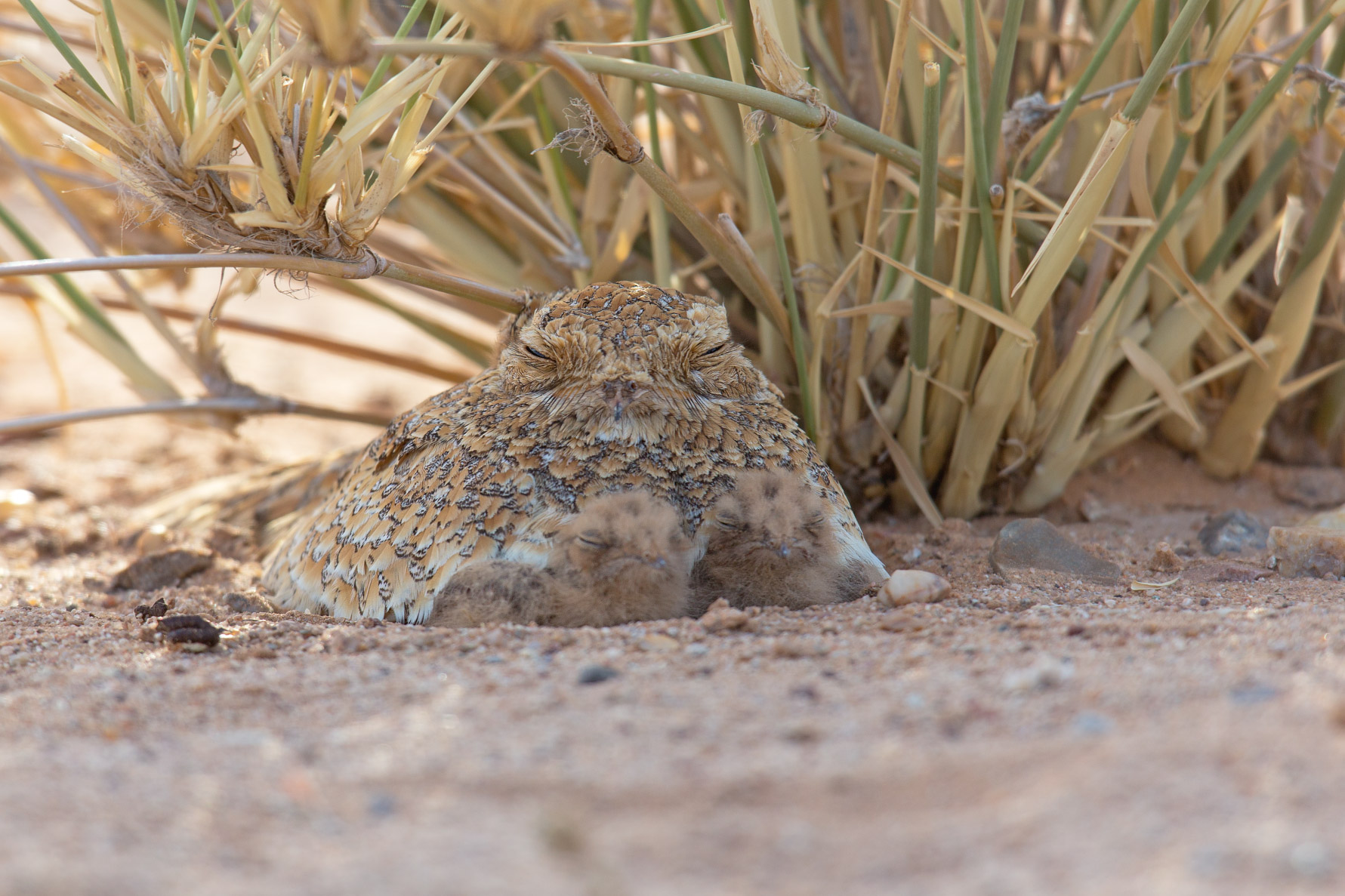
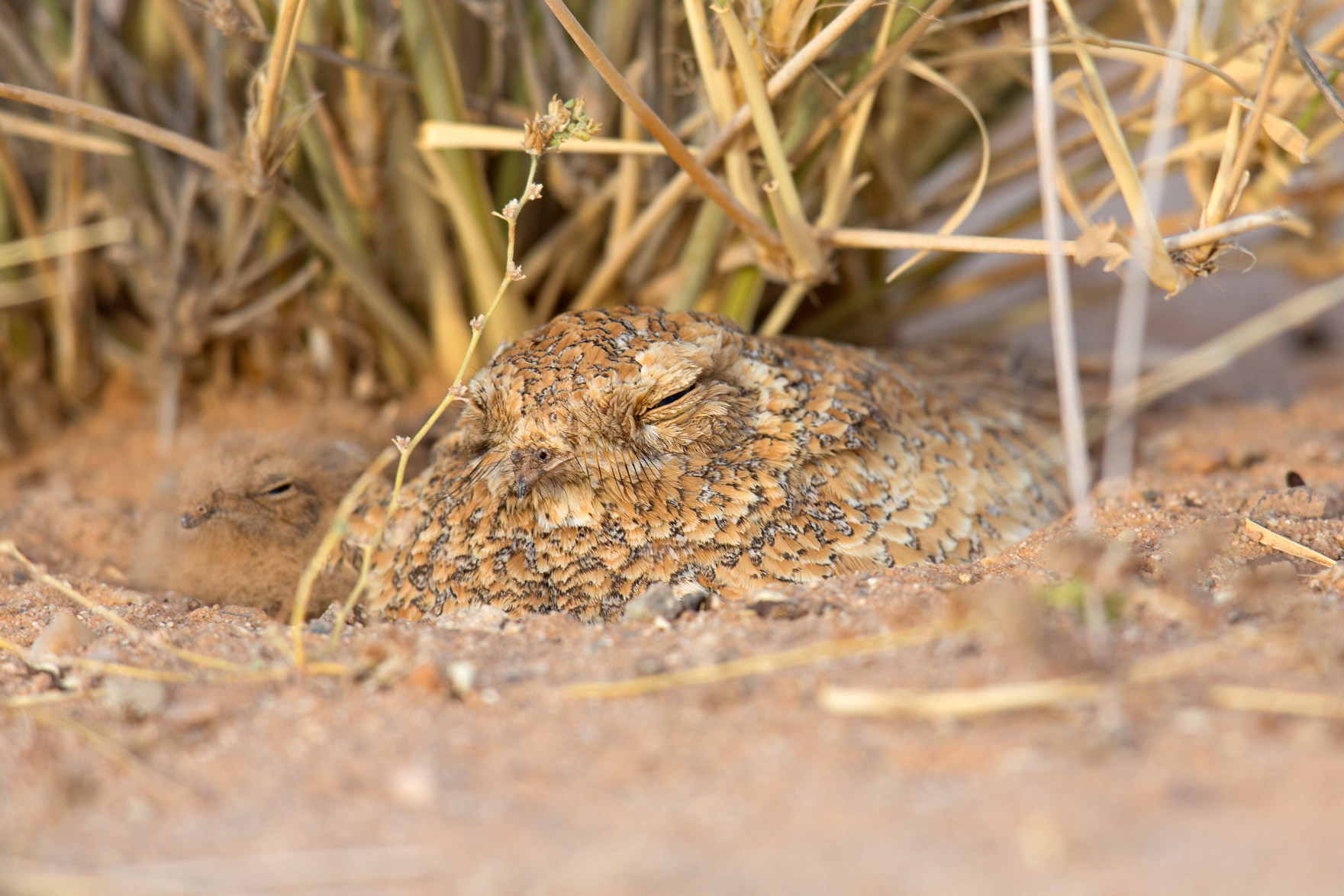
Female Golden Nightjar with chicks, Western Sahara, March 2019 (Felix Timmermann).
After we ate an evening meal of lamb by the fire, I set out for one final visit: the sun was setting and we were already packing things back up in the car. The female was again separate from the chicks; she started to open her eyes a fraction and bob her head while giving soft calls. I took some final pictures and left them to it.
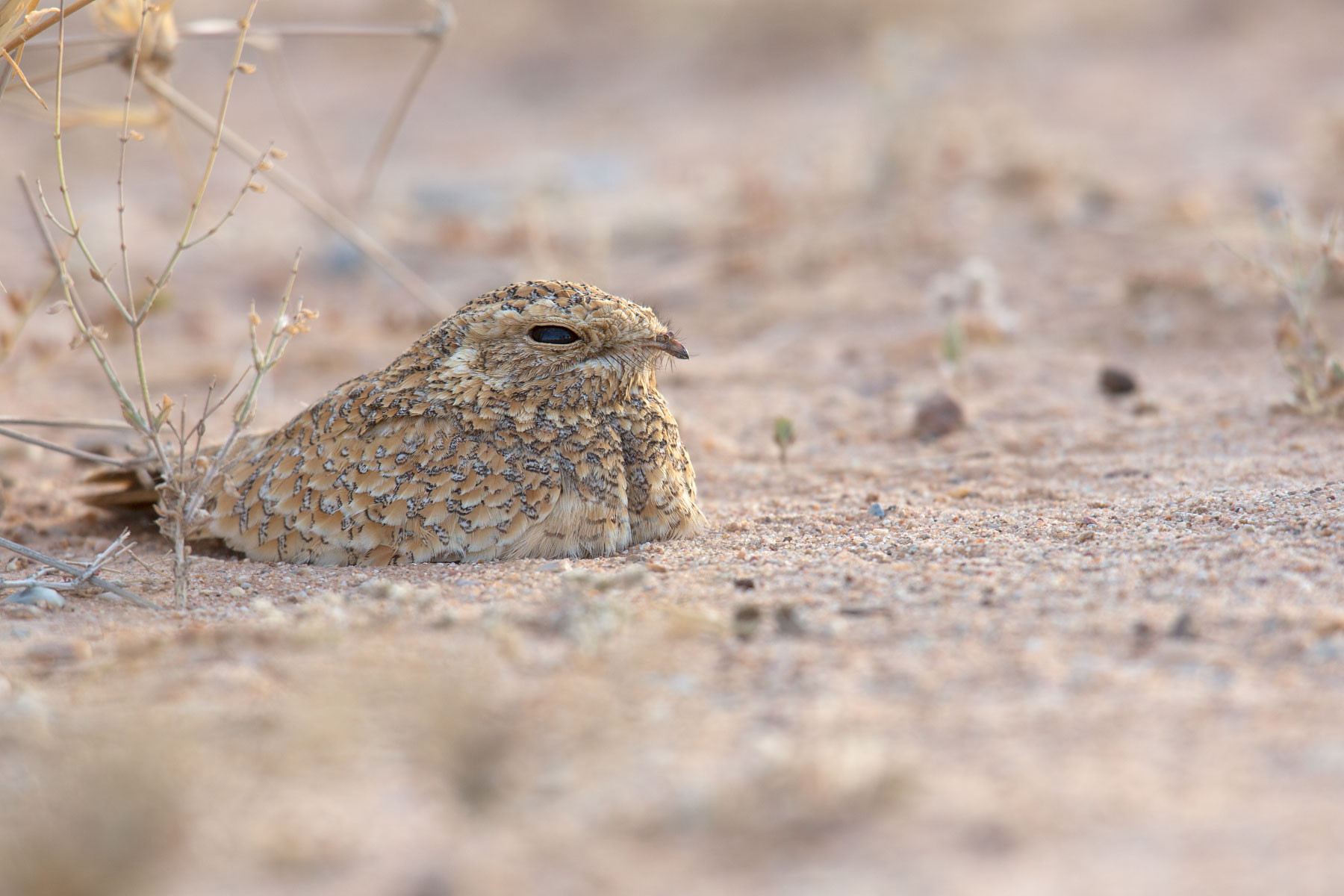
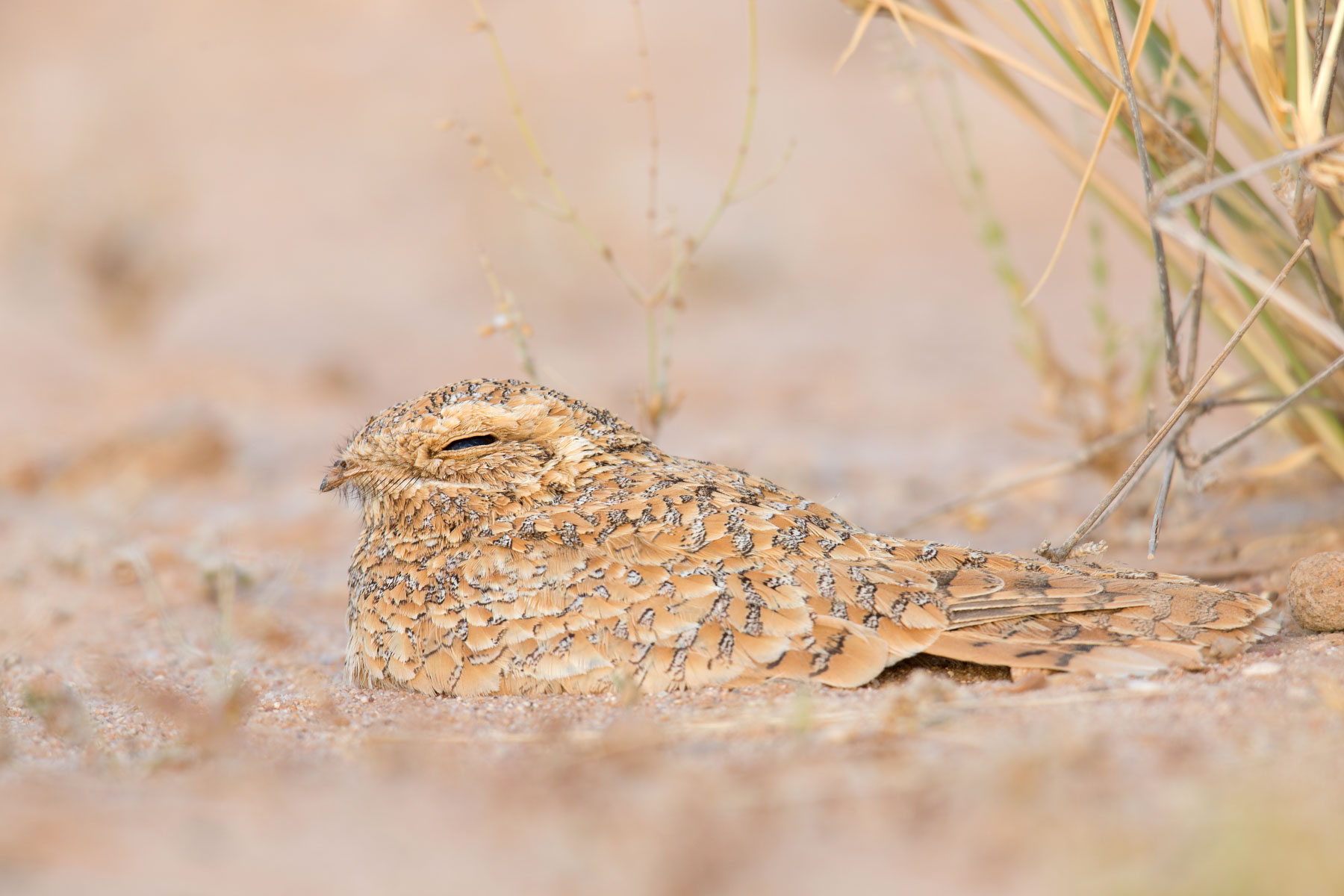
The setting sun made the beautiful plumage tones really stand out (Felix Timmermann).
In the dark it took over three hours to get back to my car, which to my relief was exactly where I had parked it. My companions were gold prospectors and actually gave me some gold encased in sandstone, so I thanked them in return by giving them a pyrite crystal I had bought in the Atlas Mountains the week previously. We exchanged telephone numbers and I hope they will have a chance to read this. This day, the bird and people will always stay in my mind.
This spring, then, Golden Nightjar has finally been proven to breed in the Western Sahara. Since then the site has been visited by a number of birders and the two chicks are in good health and have started flying. Where else these beautiful birds occur in the Western Sahara and perhaps even Morocco, time will tell.
Subscribe to:
Posts (Atom)


















